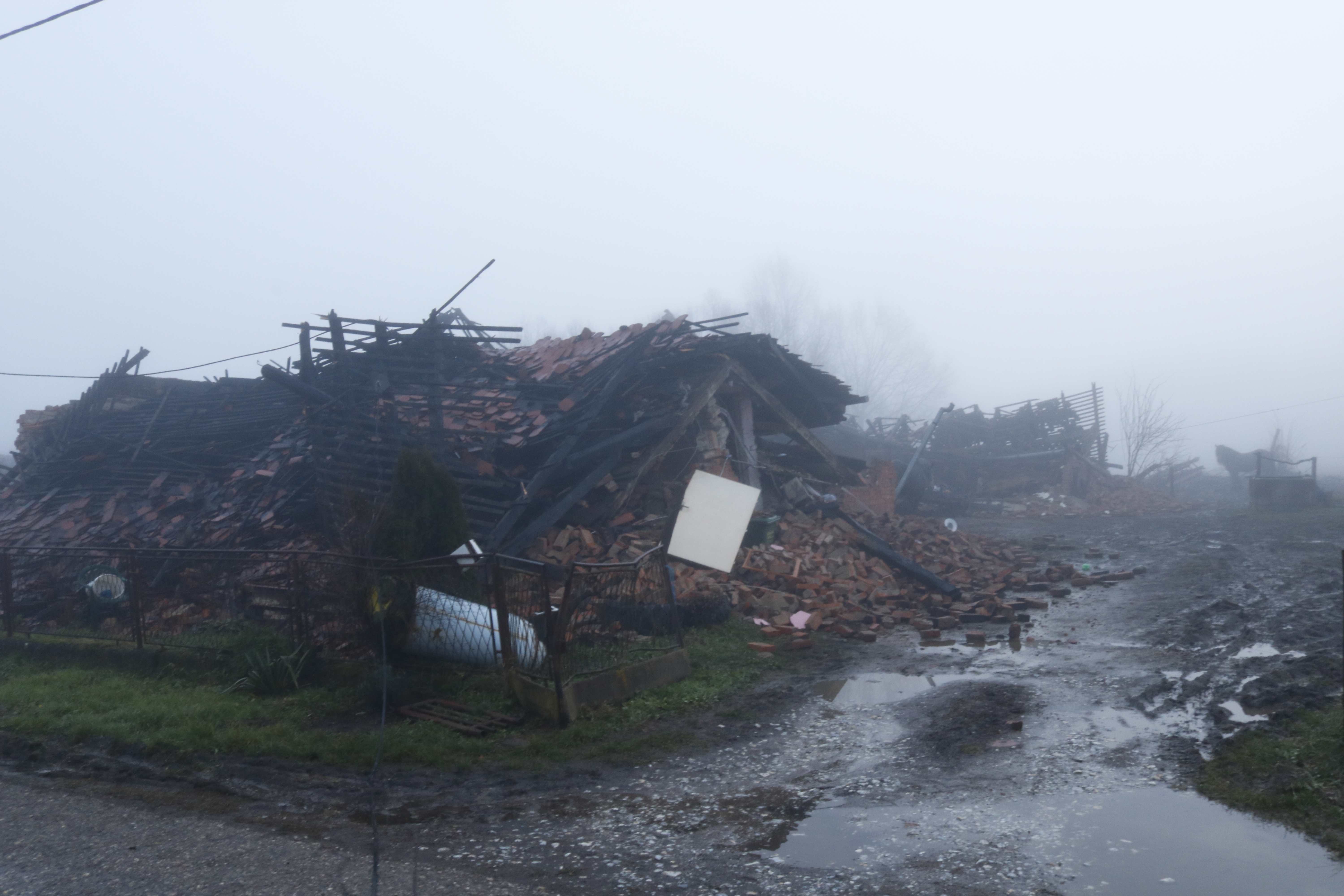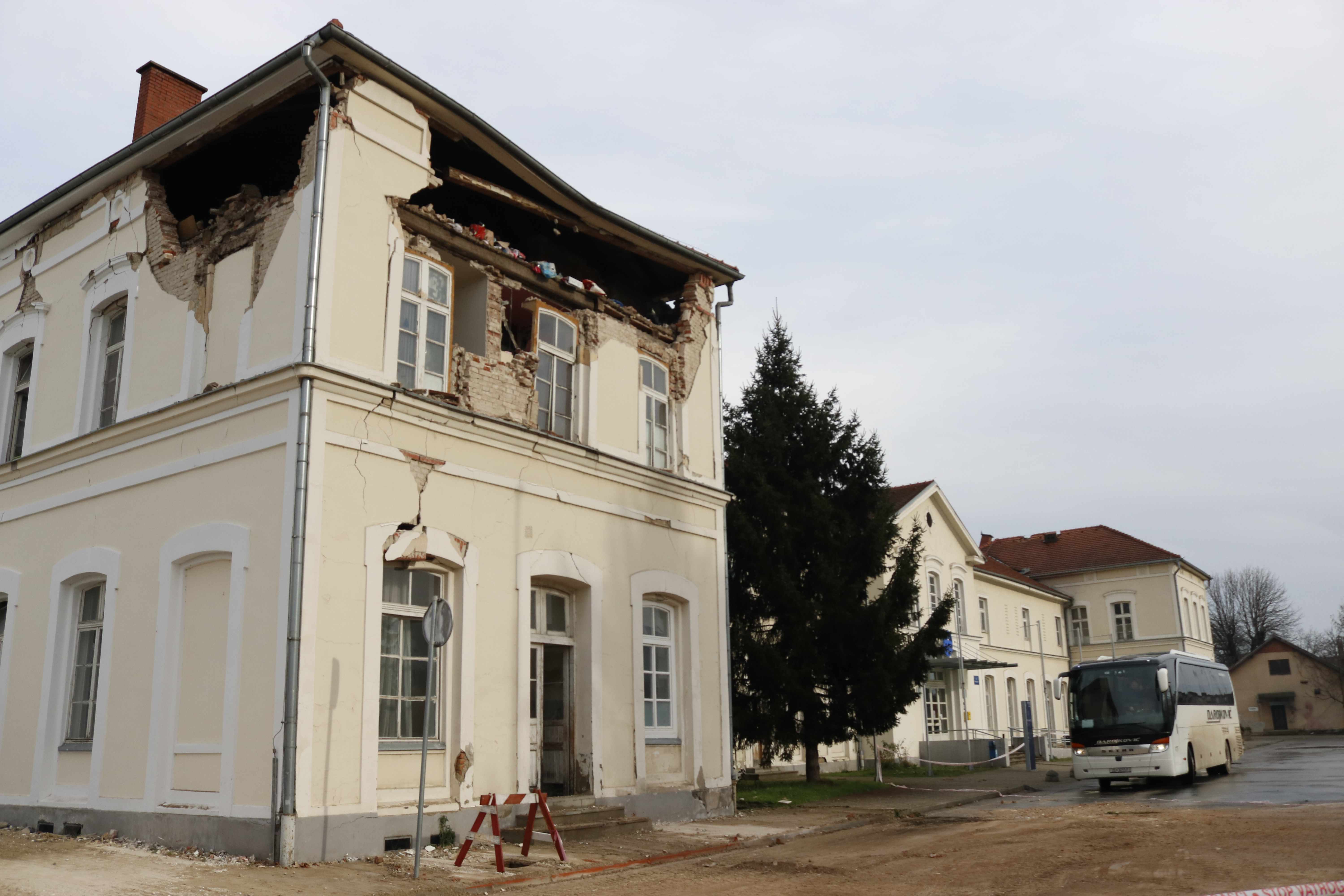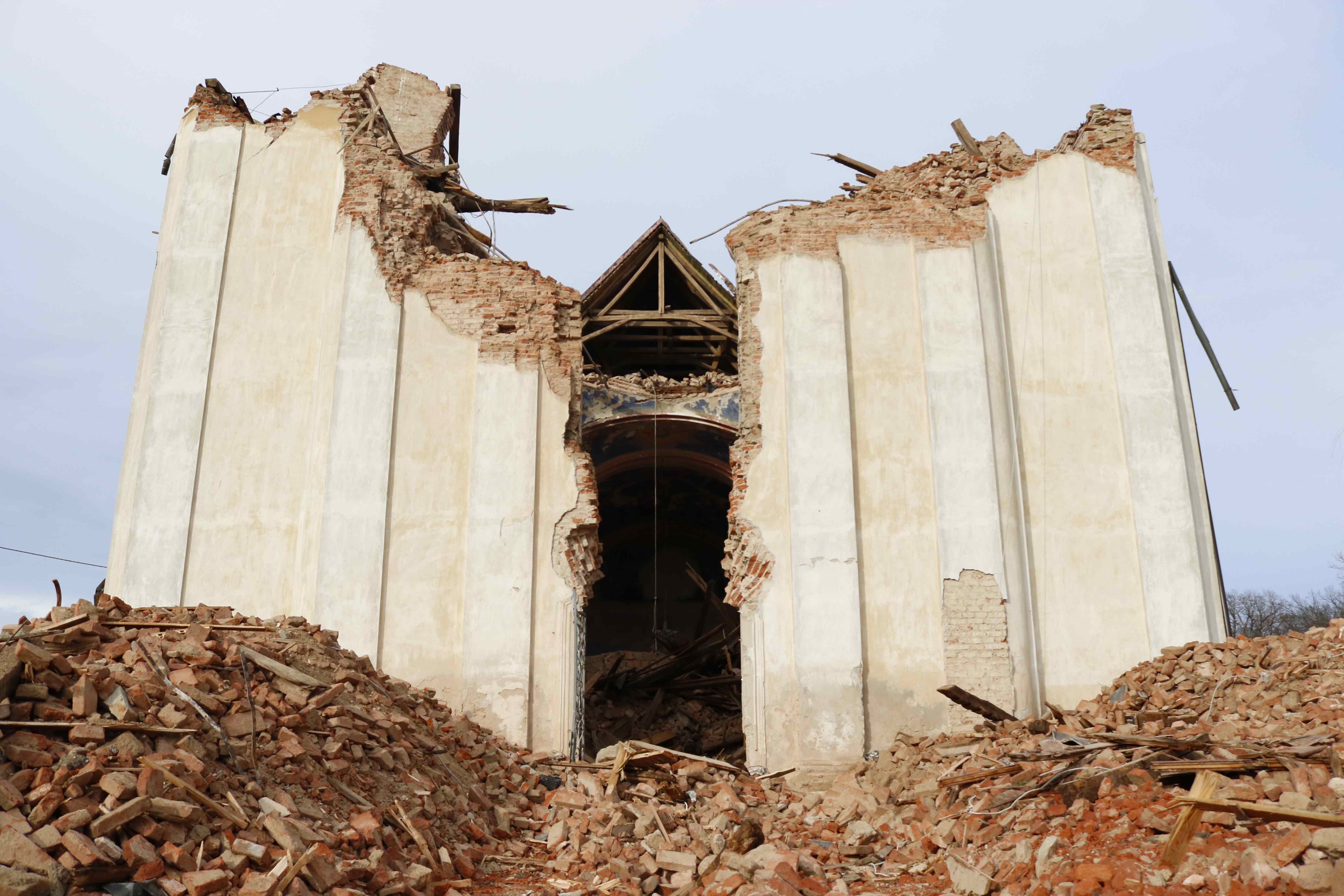Majske Poljane, Glina, Petrinja: Pogled stranca na hrvatski odgovor na katastrofu
30. prosinac 2020. – Dan nakon razornog potresa u Petrinji, TCN je posjetio Majske Poljane, Glinu i Petrinju, te tamo pronašao tragediju, humanost i Hrvate koji daju sve od sebe.
Moj prvi i jedini posjet Petrinji bio je u zimi 2003. godine. Iz nekog sam razloga, kojeg se sada ne mogu sjetiti, morao ići pokupiti Ukrajinca zaposlenog u OSCE-u i njegovog sina. Sin mu je slomio nogu i moj je zadatak bio odvesti ga do bolnice u Zagrebu. Malo se toga sjećam iz Petrinje osim snijega i mnogih srušenih zgrada koje su ostale nakon godina rata i neprijateljske okupacije desetak godina ranije.
Nije se mnogo toga promijenilo za ljude Petrinje i okolice u 25 godina otkako je rat završio. Nezaposlenost, emigracija – nažalost, česta priča u kontinentalnoj Hrvatskoj, osim u glavnom gradu Zagrebu. Potres jačine 6.2 osjetio se u deset drugih zemalja i u svim dijelovima Hrvatske – bio je to moj prvi potres u životu, za vrijeme ručka u Varaždinu, udaljenom 140 kilometara, dovoljno jak da odmah napustimo kuću.
Kako smo pratili posljedice na TCN-u, bilo je jasno da se radi o ogromnoj tragediji, dok je unutar nekoliko sati objavljeno da ima barem sedam žrtava. Međunarodne poruke i obećanja za pomoć počeli su dolaziti, a zanimanje za naše vijesti uživo iz inozemstva bilo je ogromno. Odlučio sam sljedeći dan posjetiti tu regiju, u nadi da će detaljan izvještaj o situaciji na terenu pomoći ljudima da shvate opseg tragedije, kao i realno prikazati sliku o tome što se događa na terenu.
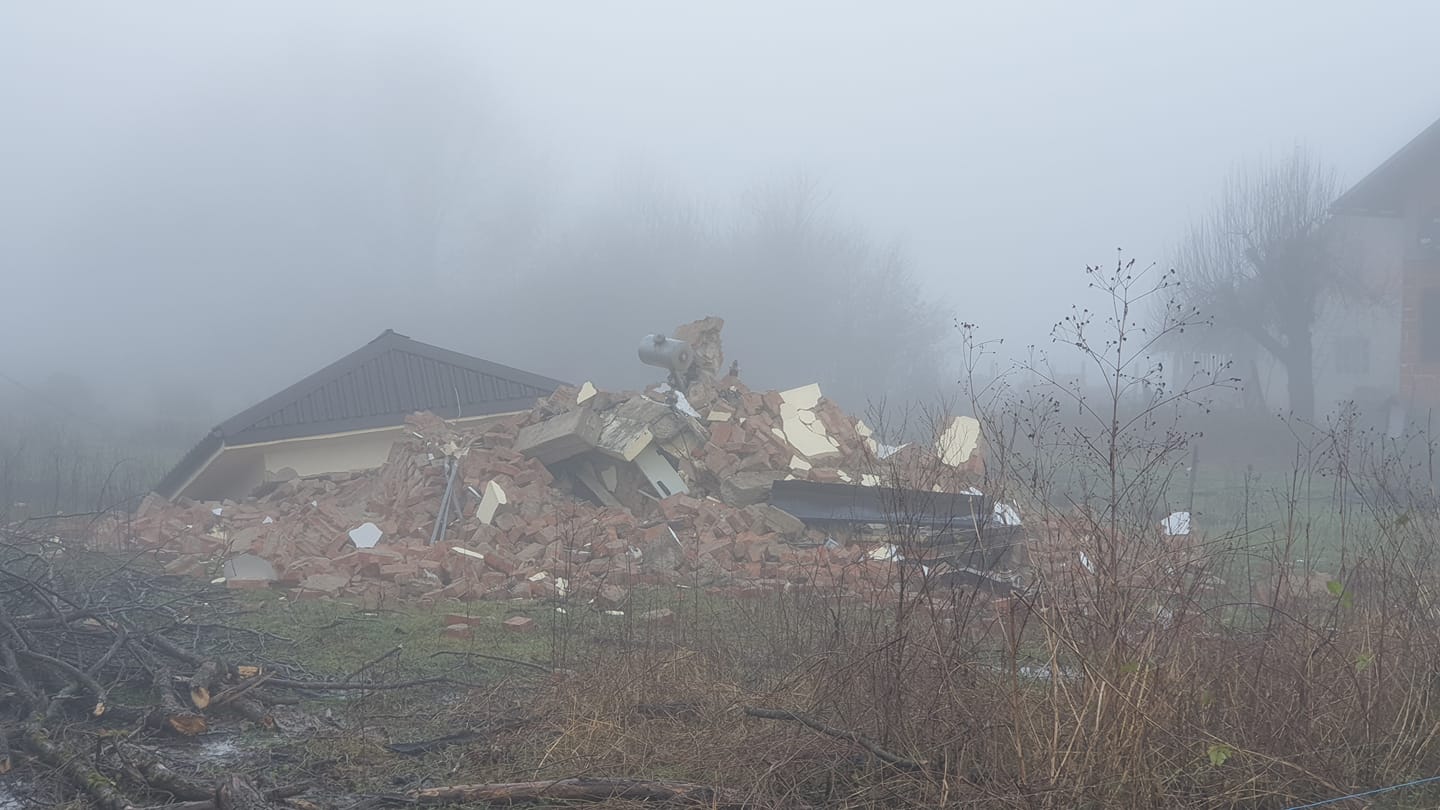
Kako nisam bio siguran kakvo će biti stanje na cestama, od kuće u Varaždinu sam krenuo u 5 ujutro, a u Zagrebu usput pokupio kolegu s TCN-a Marca Rowlandsa. Kako nikad prije nismo radili ništa slično, odlučili smo da ćemo zastati u Majskim Poljanama, selu u kojem je stradalo četiri od sedam žrtava, a u kojem načelnik tvrdi da je samo 10 % zgrada neoštećeno.
Načelnik nije pretjerivao.
Magla je na trenutke bila gusta, a mi smo postajali sve očajniji dok smo vozili po uskoj glavnoj cesti. Kako se zajednica može oporaviti od nečeg ovakvog? Ponovo izgraditi?
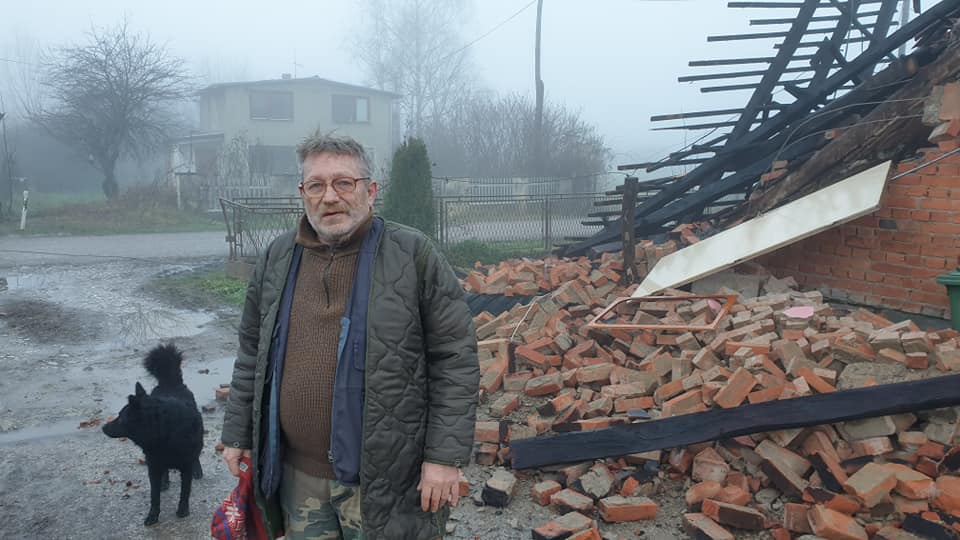
Šokiran čovjek sjedi uz cestu. Kuća mu je uglavnom u dobrom stanju, ali on je sam i nema struje. Susjedi mu nisu tako dobro prošli. Kad je čuo da sam Englez, rekao mi je da je ratni veteran i da se borio uz jednog Engleza u Vinkovcima 1992. u 109. brigadi.
„Jel se on možda zvao Steve?“, upitao sam ga, jer se radi o jedinom Englezu kojeg sam znao u Vinkovcima a koji je ratovao u Hrvatskoj (i SVAKAKO jedinom Englezu koji je otvorio pub u polju usred ničega u istočnoj Hrvatskoj).
„Da, Steve. Vjerojatno me se ne bi sjetio niti prepoznao nakon svih ovih godina.“ Predložio sam da probamo, pa smo Steveu poslali poruku s gornjom fotografijom, na što je on odgovorio da mu je to lice poznato. Svijet je u Hrvatskoj doista malen.
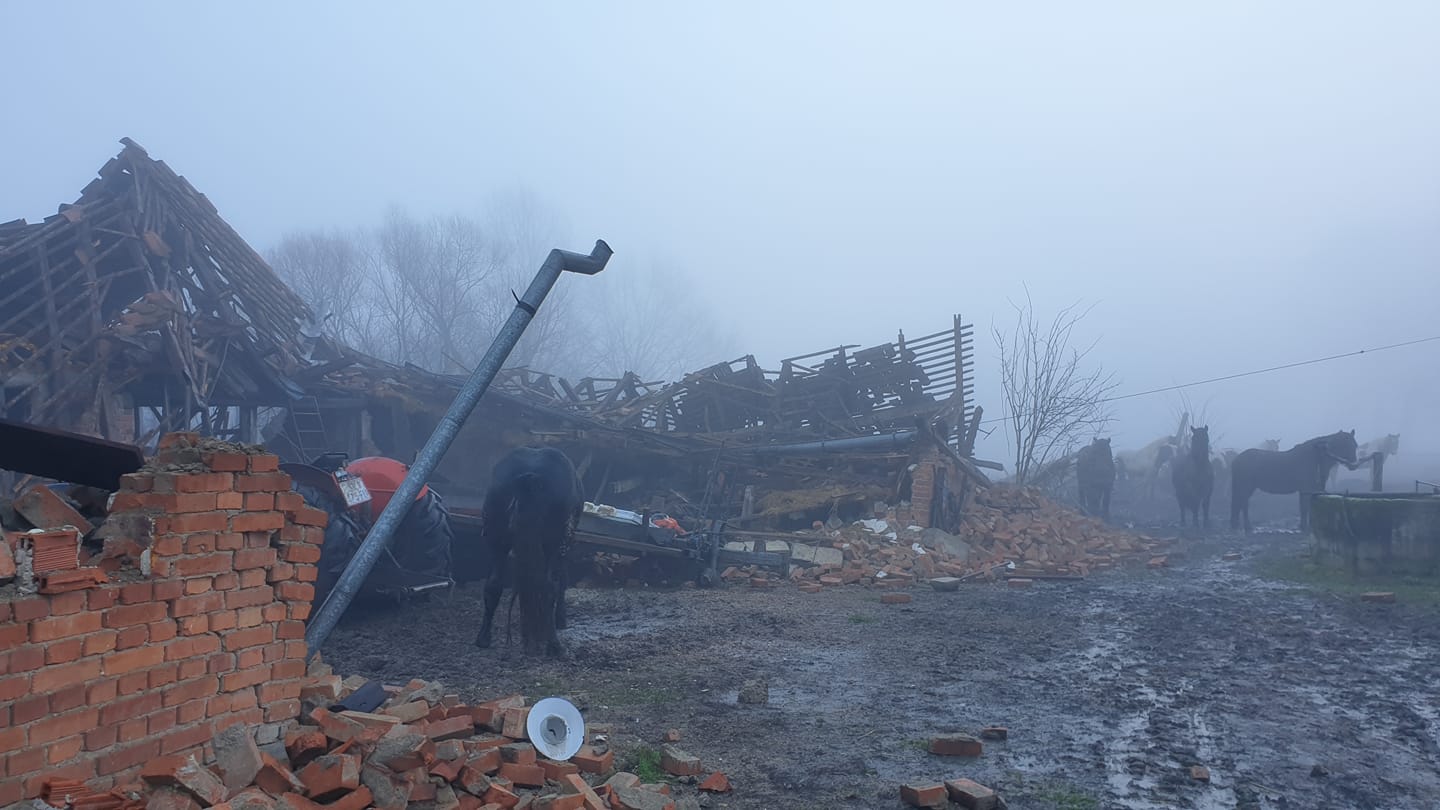
I dok je Vladimirova kuća bila u pristojnom stanju, to se ne bi moglo reći za kuću susjeda prekoputa. Jučer se radilo o kući u kojoj su živjeli ljudi. Danas, u njoj sam izbrojao desetak konja, od kojih je jedan bio vezan za traktor. Svi su bili u šoku.
Mnogim sam kolegama iz medija koje sam danas sreo ispričao o konjima i pojavili su se na nacionalnoj televiziji u vijestima, pa sam čuo da je u tu kuću stigao kontejner pomoći, uključujući i hranu za konje.
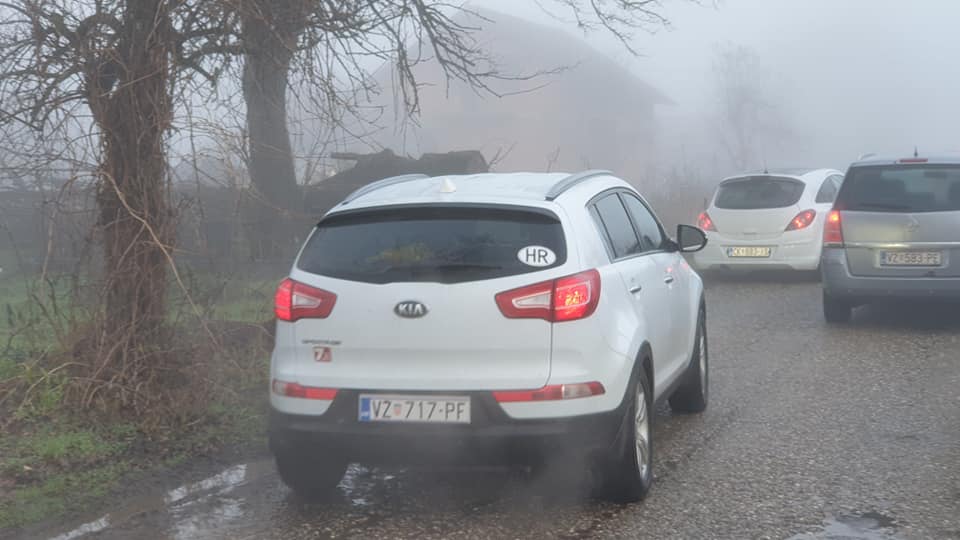
Naš auto nije bio jedini s varaždinskim tablicama u Majskim Poljanama. Bilo nas je iz Varaždina, Čakovca, Zagreba, Vukovara, Bosne. Volonteri, Hrvati i stranci s punim automobilima hrane, deka, vode, odjeće, tražili su domaće stanovništvo da bi im pomogli da prebrode ovaj težak period.
Vladimiru je dan ranije već došla pomoć od Crvenog Križa, donijeli su mu hranu, odjeću i pokrivače. Uzeo je samo malo hrane, jer bi drugima moglo više trebati.

To je bila slika dana – automobili iz cijele Hrvatske (ovdje prikazan iz Našica) napunjeni namirnicama da bi pomogli ljudima Majskih Poljana, Gline, Petrinje i Siska.
Od svih zemalja u kojima sam živio ili kroz njih putovao, nikad nisam vidio naciju koja se tako ujedini u vremenima krize ovako kako se Hrvatska ujedini. Dok mi se srce slamalo od scena užasa na sve strane, jednako je tako bilo puno ponosa na sve što čine ljudi u mojoj odabranoj domovini.
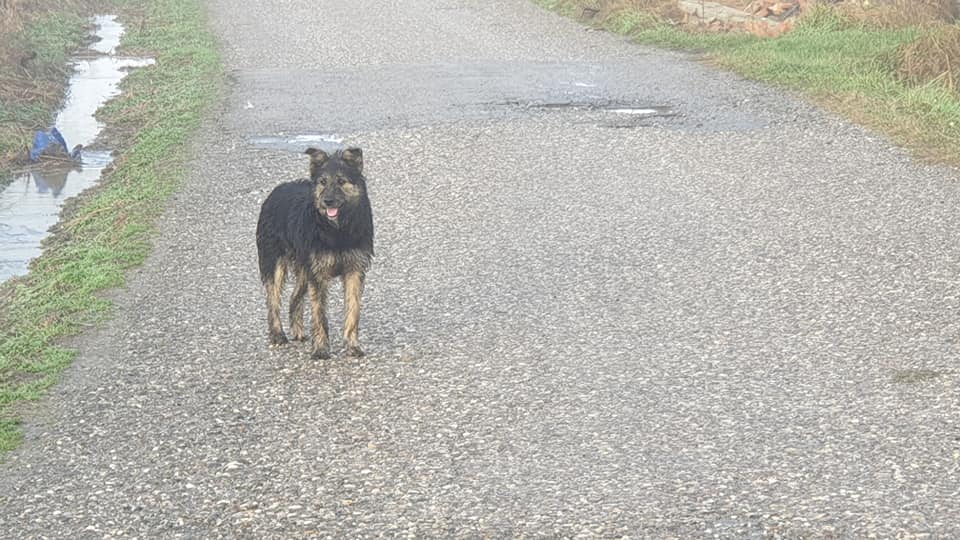
Ljudi Majskih Poljana vjerojatno su bili zbunjeni svime što se dogodilo, a jednako su tako zbunjene bile i životinje. Od onih konja do ovaca i mnogih pasa koji su ili lutali okolo ili čuvali kuće koje više ne postoje, usamljenost i izgubljenost kod omiljenih ljubimaca na mene je ostavila najjači trag danas.
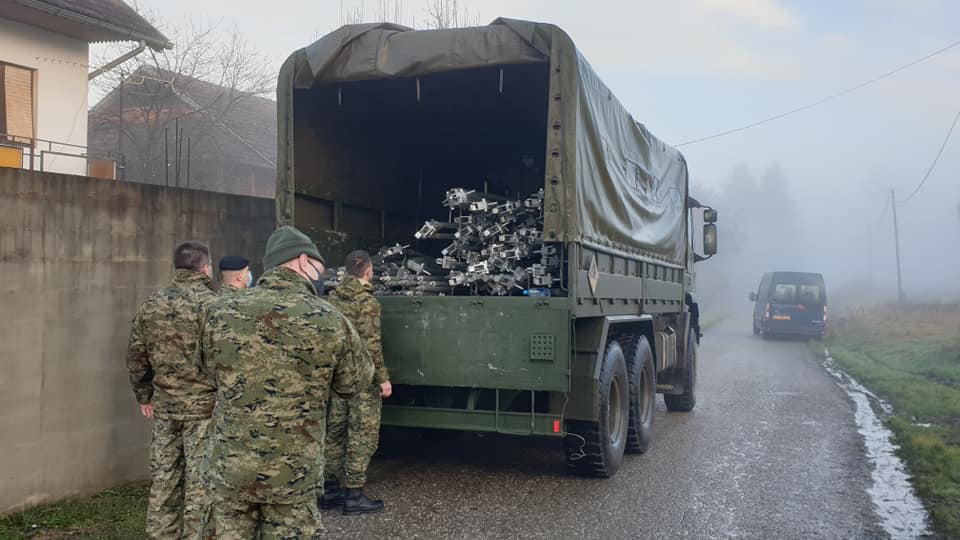
Prošli smo kroz maglu na drugu stranu Majskih Poljana, gdje nas je dočekala Hrvatska vojska, koja je među prvima došla odgovoriti na izvanrednu situaciju.
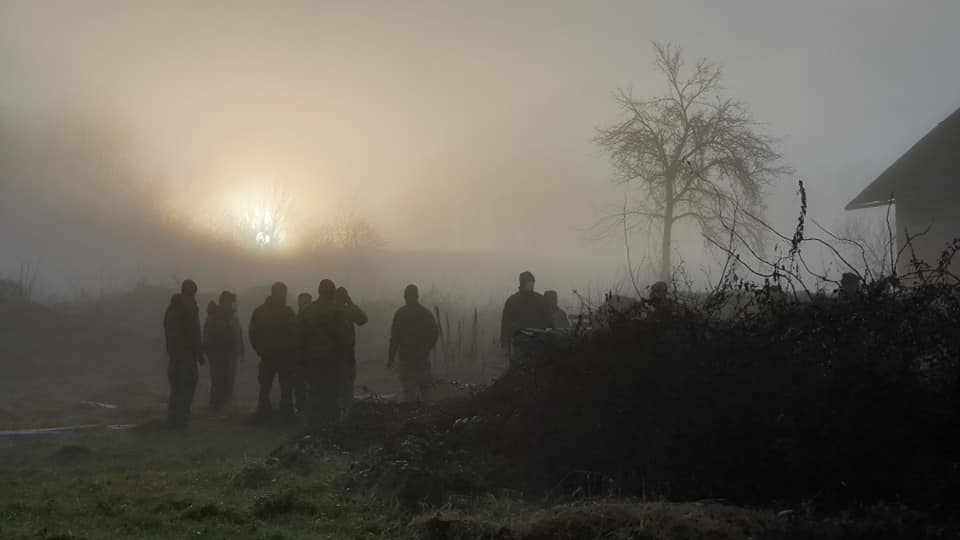
Uskoro su bili vrijedni postavljajući privremena skloništa za stanovnike.

Sjajan timski rad, očito dobro uvježban.
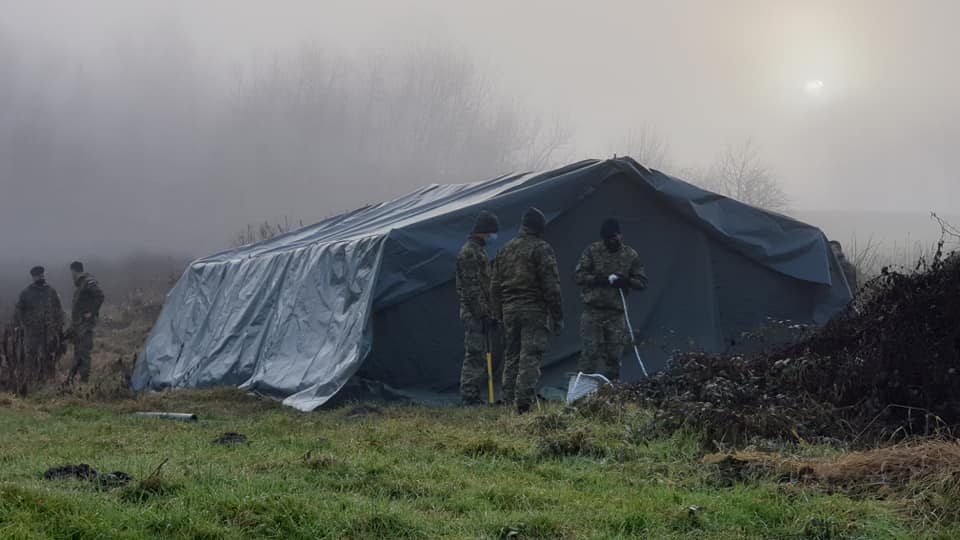
I za 15 minuta, zadatak izvršen, prvi šator postavljen.
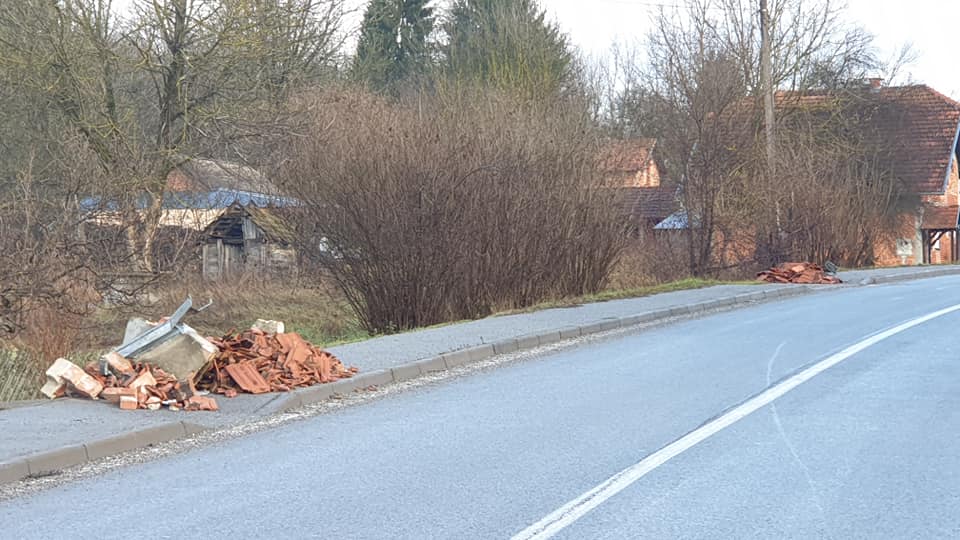
Uputili smo se prema najbližem gradu, Glini, koja je također teško oštećena. Putem, uz rub ceste vidjeli smo hrpe smeća od oštećenih kuća. Uredno složene, čekaju da ih netko dođe pokupiti.
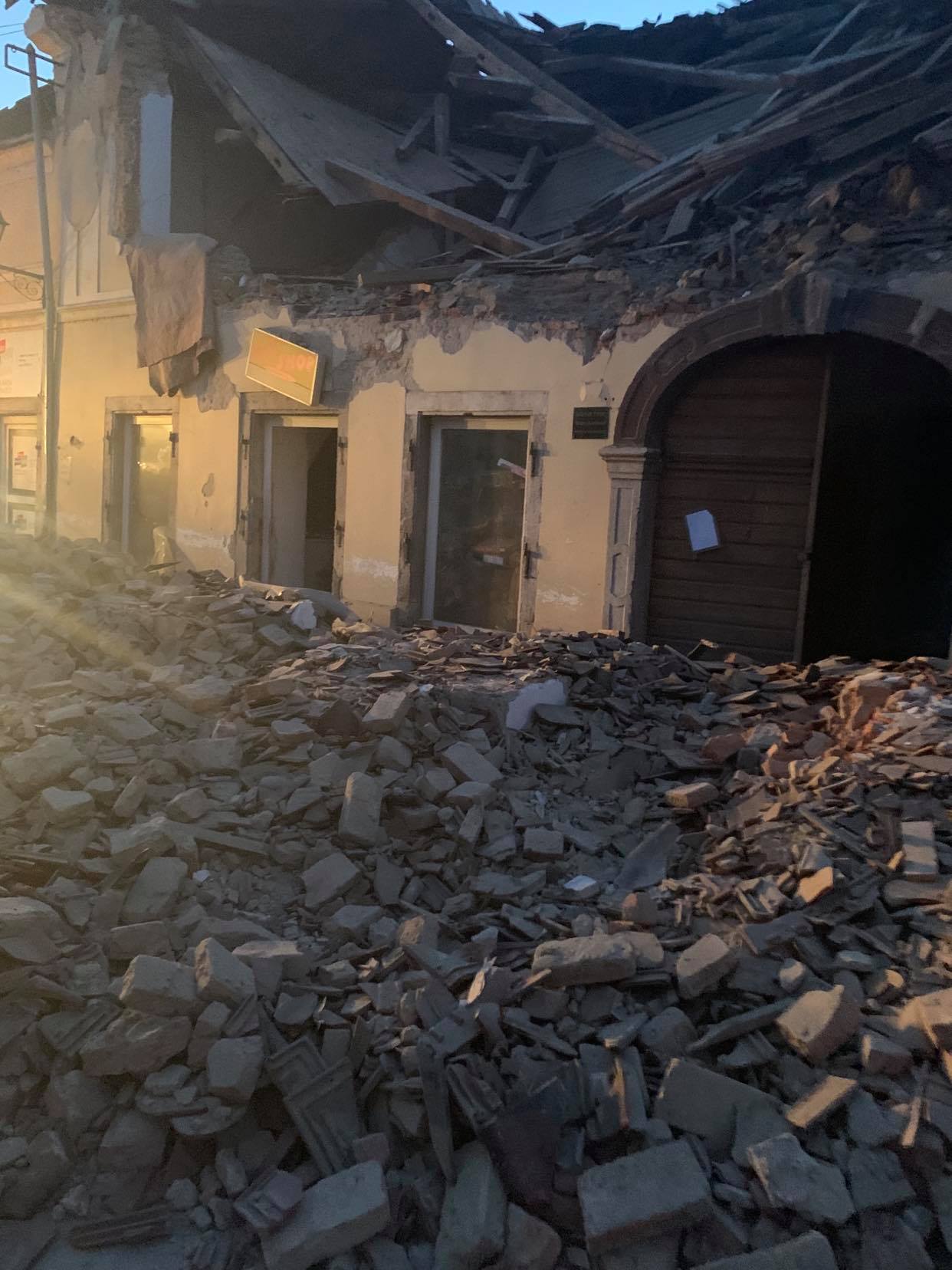
Ovu mi je fotografiju Petrinje prijatelj poslao jučer. Čišćenje ovoga će trajati zauvijek, čini se.
Nismo mogli vjerovati koliko su ulice Gline čiste, dok nismo vidjeli ekipe domaćih ljudi u akciji.
Jedan dio očišćen, idemo dalje.
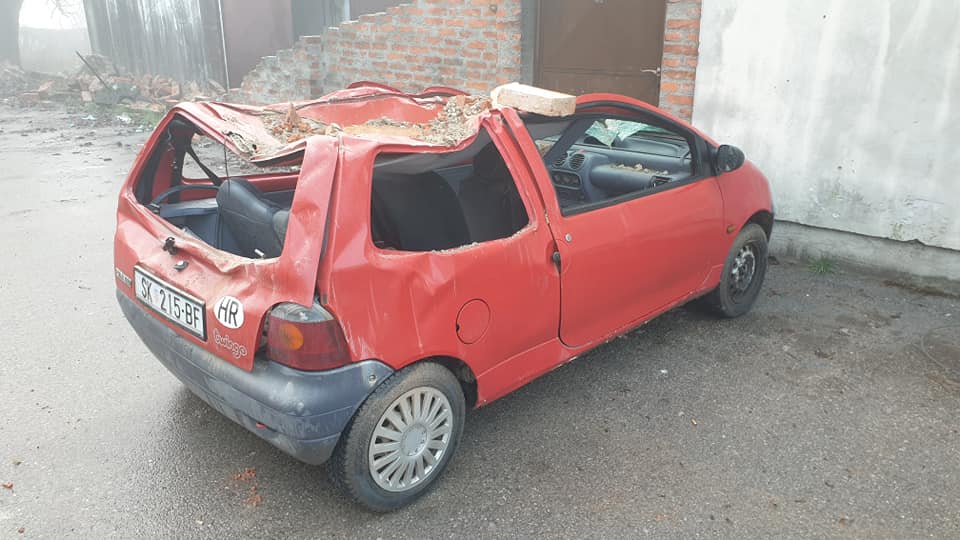
Neke stvari neće biti moguće popraviti.
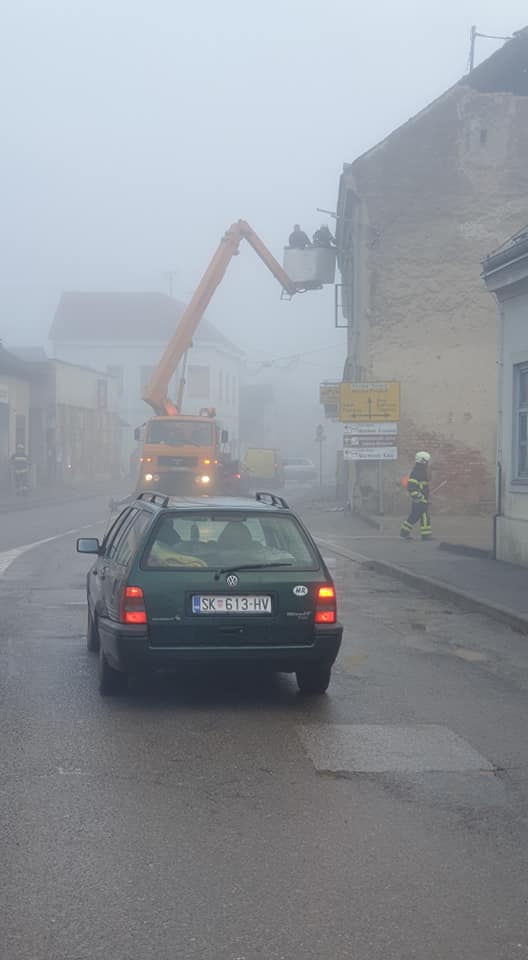
Vatrogasci su davali sve od sebe, uklanjali otpad i nastojali zgrade učiniti što sigurnijima. Mnogi su oštećeni dimnjaci uklonjeni u regiji tijekom dana.
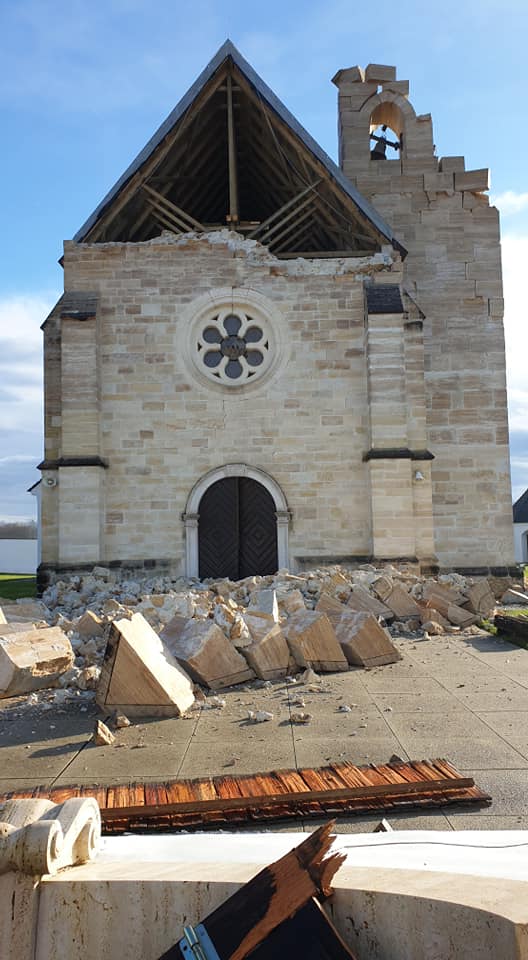
Iz Gline smo krenuli prema Petrinji, ali putem je bilo svašta vrijedno pažnje. Prekrasna kamena crkva u Gori, žrtva potresa, s ogromnim komadima kamena koji leže u vrtu. Jedan stanovnik rekao mi je da je crkva stara tek nekoliko godina, jer je bila obnovljena nakon Domovinskog rata.
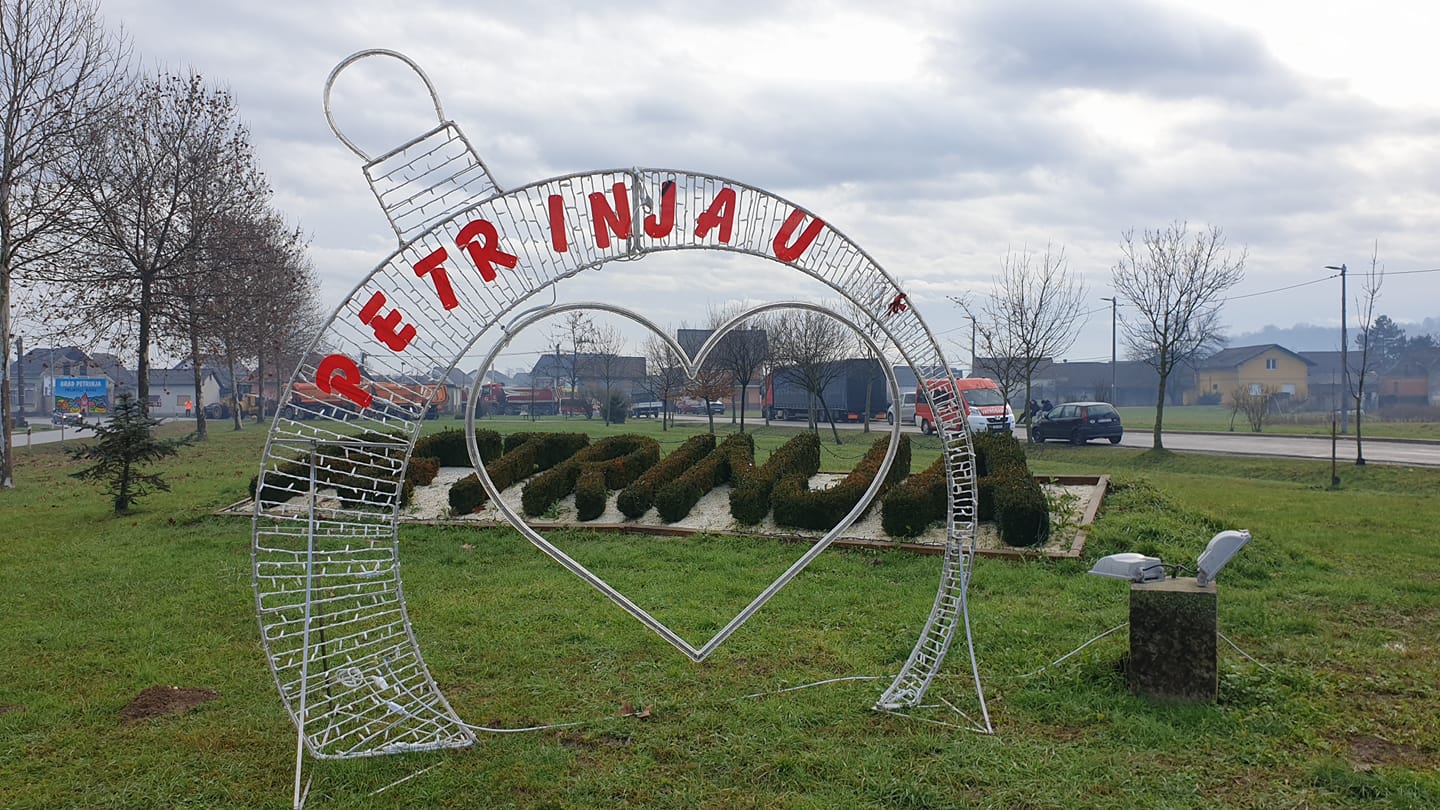
Ulaz u Petrinju.
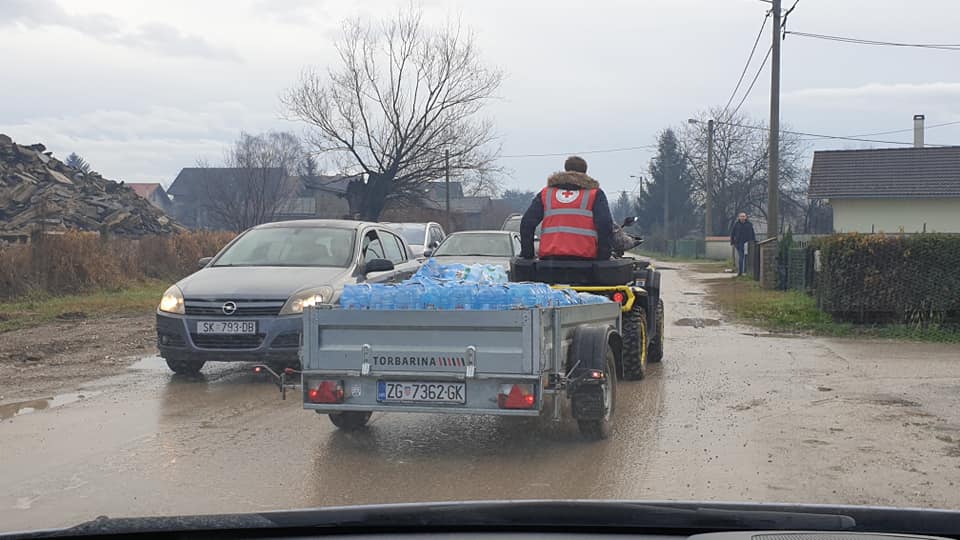
Kako nismo imali neki jasan plan, odlučili smo slijediti stvari koje su nas zainteresirale. Kao što je, naprimjer, bio Crveni Križ koji je na quadovima dostavljao vodu.
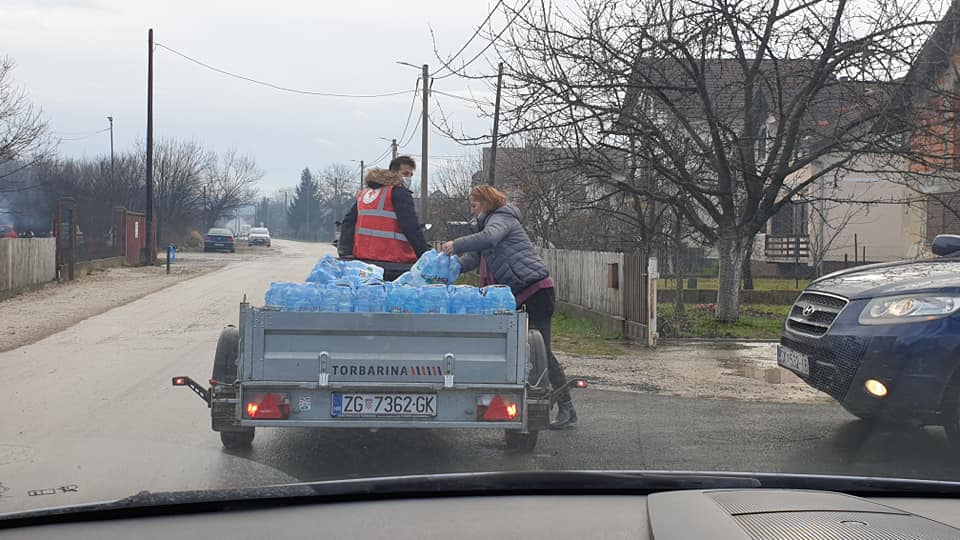
Nije ih bilo lako pratiti dok su išli od kuće do kuće. Stanovnici su izlazili da bi preuzeli ono što im pripada. Brzo, inovativno i vrlo učinkovito.

Među najtužnijim prizorima svakako su bile brojne obitelji koje su sjedile u dvorištima, na otvorenom, s osnovnim namirnicama i vodom. Neki su samo stajali i izgledali izgubljeno. Uz prijetnju od novih podrhtavanja, bez struje i bez mjesta gdje su mogli otići, mnogi su samo sjedili vani na hladnom i čekali. Mogli smo tada snimiti fantastične fotografije, ali nismo htjeli biti toliko nametljivi.
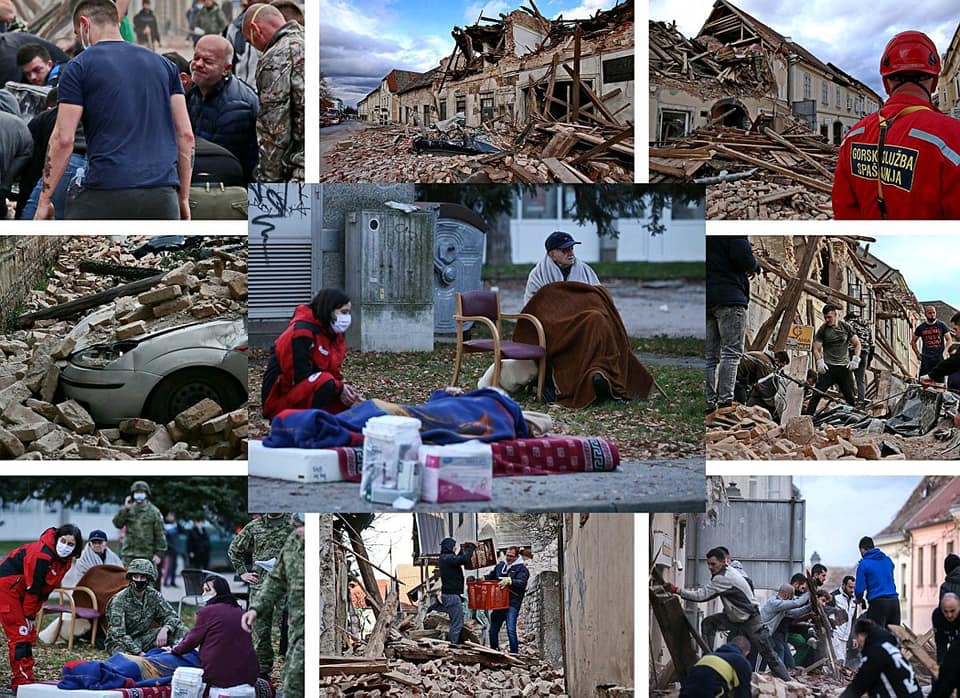
Ali, jedan od mojih kontaka s LinkedIna postavio je ovaj kolaž koji vam to može približiti.

Stigli smo i do centra Petrinje, čije su srušene zgrade postale prepoznatljivo povezane s ovom posljednjom katastrofom.

Zastrašujuće.

Ali onda, čudo… Pogledaš na drugu stranu, prema sredini trga i ugledaš Advent u Petrinji, koji izgleda kao da razumije ništa od onoga što se oko njega događa.
Video obilazak dvije Petrinje na jednom trgu.
I ponovo sam se sjetio fotografije mog prijatelja od prethodnog dana – ulice Petrinje bile su nevjerojatno čiste, tako brzo nakon katastrofe.
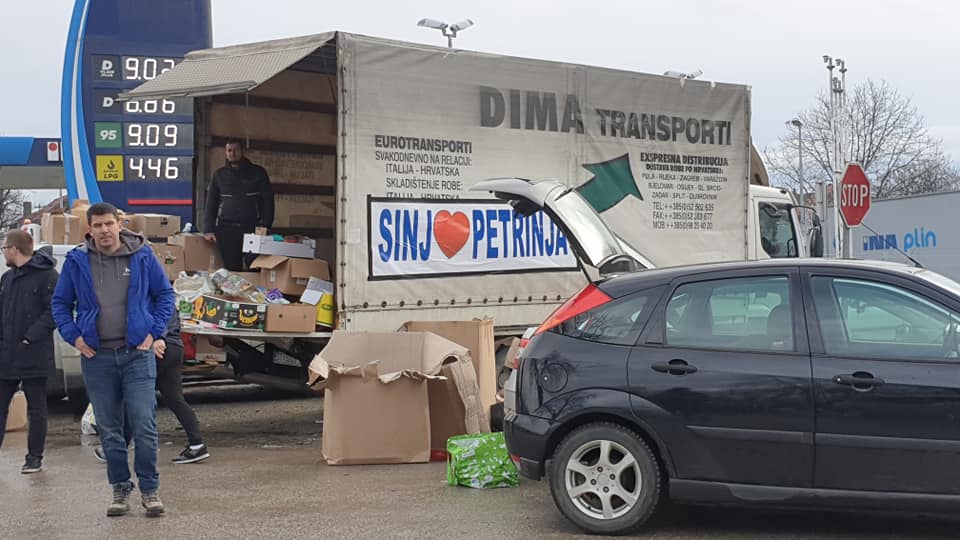
Drugi razlog zašto su ljudi možda sjedili u svojim dvorištima je to što ništa nije bilo otvoreno. Restorani i kafići zatvoreni su već tjednima zbog korone, ali ovdje su bili zatvoreni i dućani i supermarketi. Ali nije bilo baš šanse da ljudi u Petrinji ogladne, jer je stigla pomoć iz cijele Hrvatske. Zaustavio sam se da bih poslikao kako „Sinj voli Petrinju“. Čovjek me sa snažnim sinjskim naglaskom pitao što trebam. Odgovorio sam da bih rado jedno hladno pivo. Kaže on meni: „Nemamo pivo, ali imamo mnogo drugih stvari, uzmi što trebaš!“ Objasnio sam mu da se šalim, da sam novinar i da mi ne treba ništa ali da mu zahvaljujem na ponudi.
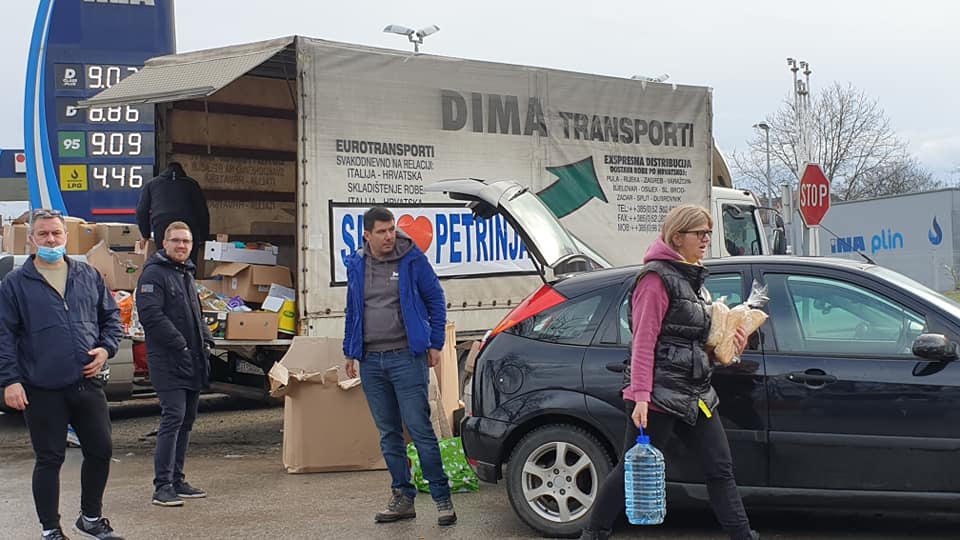
Prišla mu je žena pitati ga ima li što kruha i uzela je što je trebalo njoj i njenoj obitelji. Takve su se stvari događale po cijelom području, pokloni ljudi iz cijele zemlje danas – to je zaista bilo dirljivo.

I svugdje je bilo još volontera koji su čekali da dobiju sljedeći zadatak. Sve je bilo dobro koordinirano zahvaljujući lokalnom stožeru civilne zaštite.
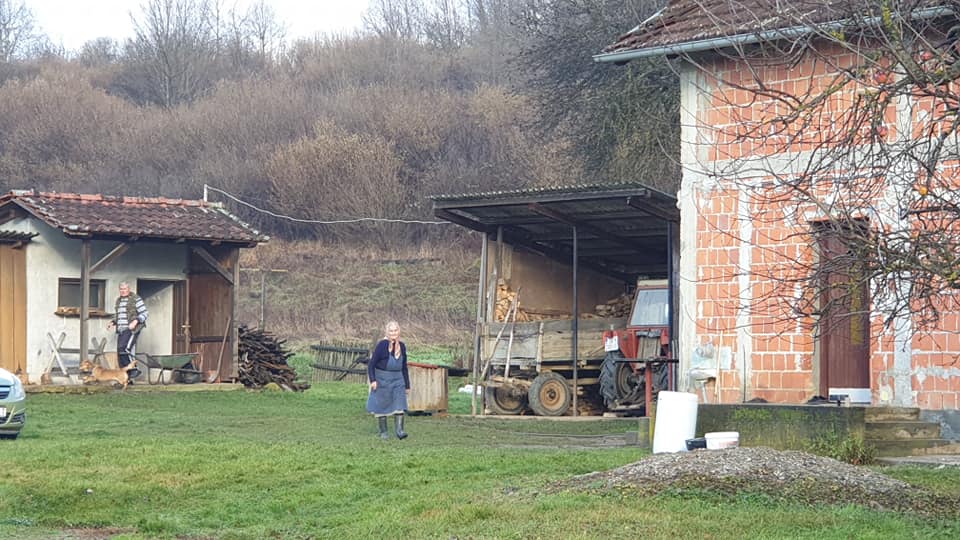
Marc je htio slikati nešto uz cestu, a ja sam se našao kako gledam kuću ovog para koja je bila oštećena, uz prioritet da se popravi krov.
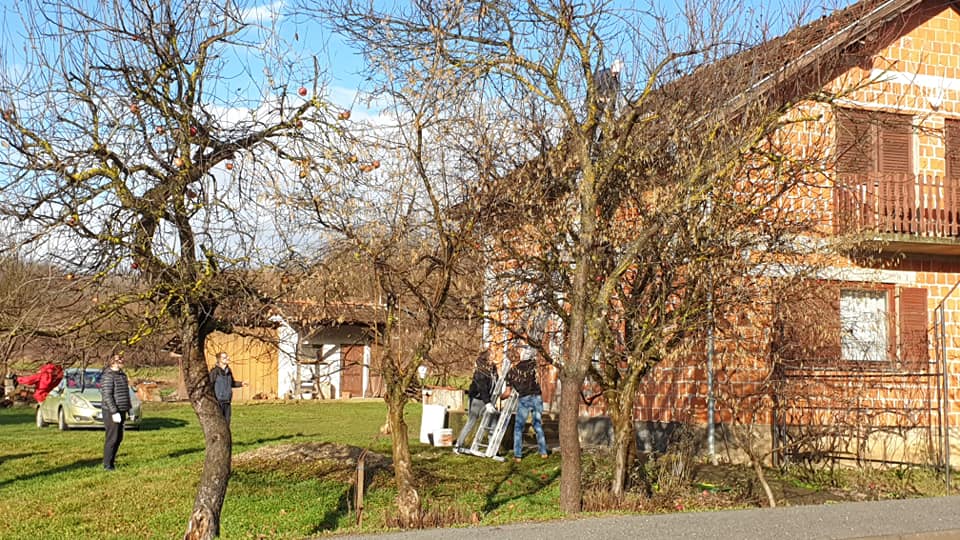
Za par minuta odnekud se pojavila grupica volontera s ljestvama i prionuli su poslu. Takve su se stvari događale po cijelom području, volonteri iz cijele zemlje – to je zaista bilo dirljivo.
Morao sam stići na vrijeme na jedan sastanak – konačno upoznati Josipa Granića i fantastičnu ekipu iz Hrvatske Gorske Službe Spašavanja, čije je sjedište bilo na parkiralištu Lidla.

Nas dvojicu povezuje to što smo podjednako neočekivano postali muški modeli (dobro, za njega je to bilo očekivanije nego za mene) u Varteksovoj kampanji „Nesavršen muškarac u savršenom odijelu“. Josip je fan TCN-a i mnogo je pomogao kad smo radili sjajan članak o fantastičnoj ekipi HGSS-ovaca ranije tijekom ove godine - Meet HGSS The Croatian Mountain Rescue Service.
Iako je radio cijelu noć i nije ništa spavao, Josip je pronašao vremena za intervju koji je dao Marcu, a koji možete pročitati ovdje.
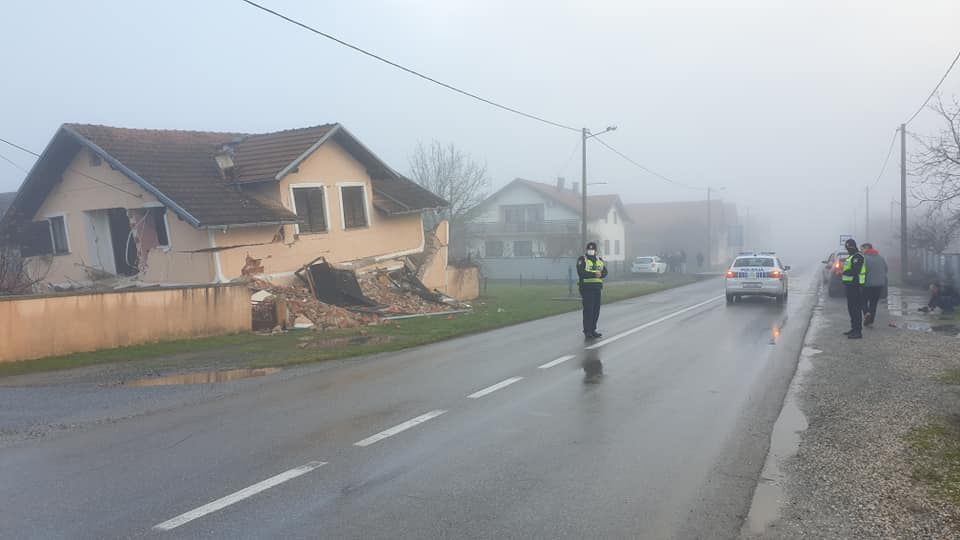
Policijske patrole u pogođenom području. Očekivao sam više zagušenja prometa, ali policija je uspijevala postići da promet teče.
Ono što policija nije mogla kontrolirati je bilo još potresa. Sjedio sam sam u autu dok je Marc fotografirao, prvo se auto počeo ljuljati s jedne na drugu stranu, a onda sam shvatio da se tlo definitivno pomiče – kasnije sam saznao da se radilo o još jednom potresu, ovaj put 4.1. Posve uobičajeno u Hrvatskoj 2020. godine.

Promet je i dalje tekao, donoseći ključne stvari u ona mjesta koja su ih najviše trebala.

Štete je bilo svugdje i svi su je mogli vidjeti.
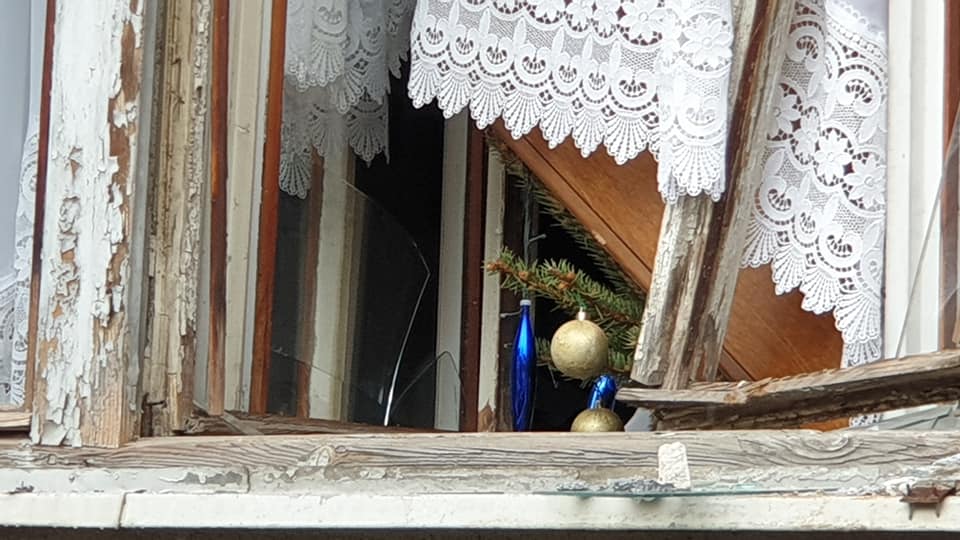
Uz neka podsjećanja na sretna vremena blagdana, prije nekoliko dana, kada je život bio potpuno drukčiji.
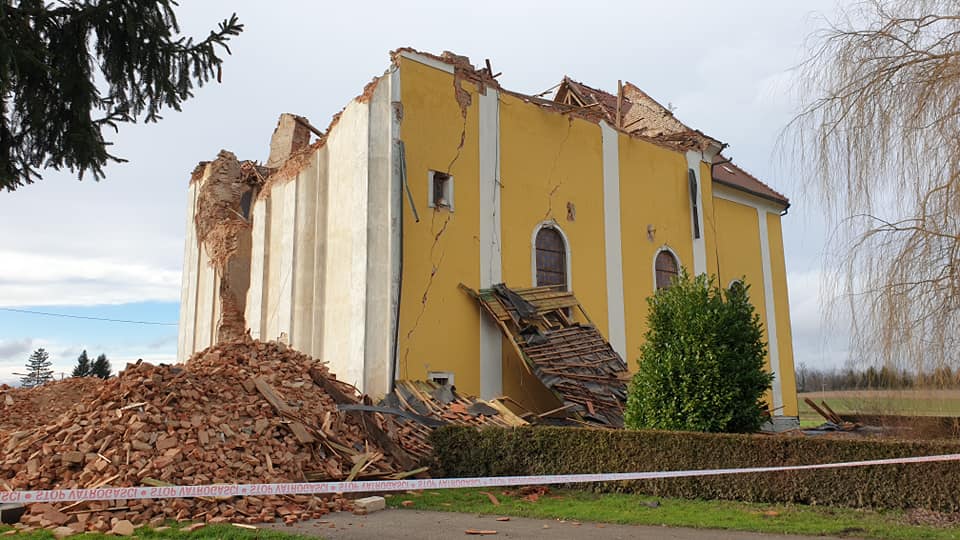
Planirali smo zastati na još jednom mjestu prije povratka u Zagreb – kod crkve u selu Žažini. Njena prednja strana i zvonik više ne postoje.
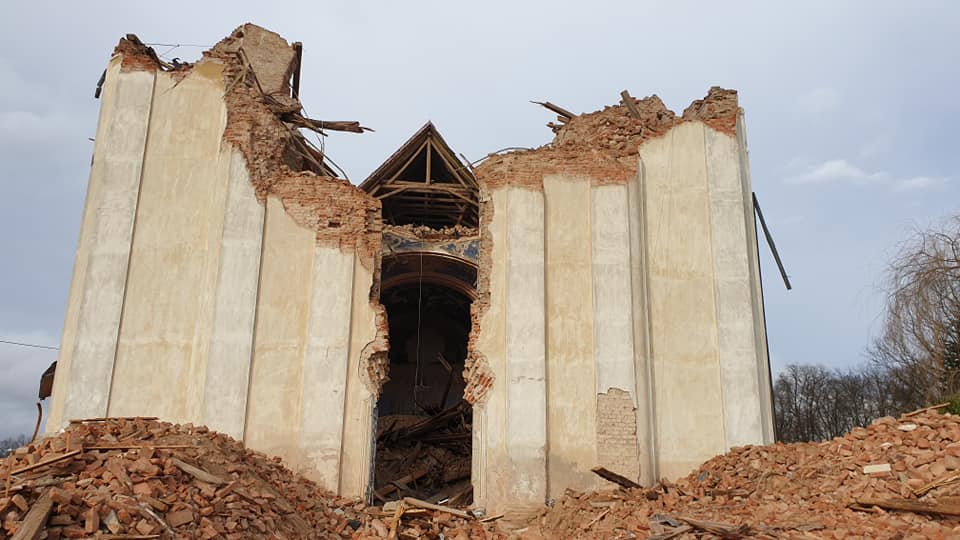
Otrgnuti od ostatka zgrade.
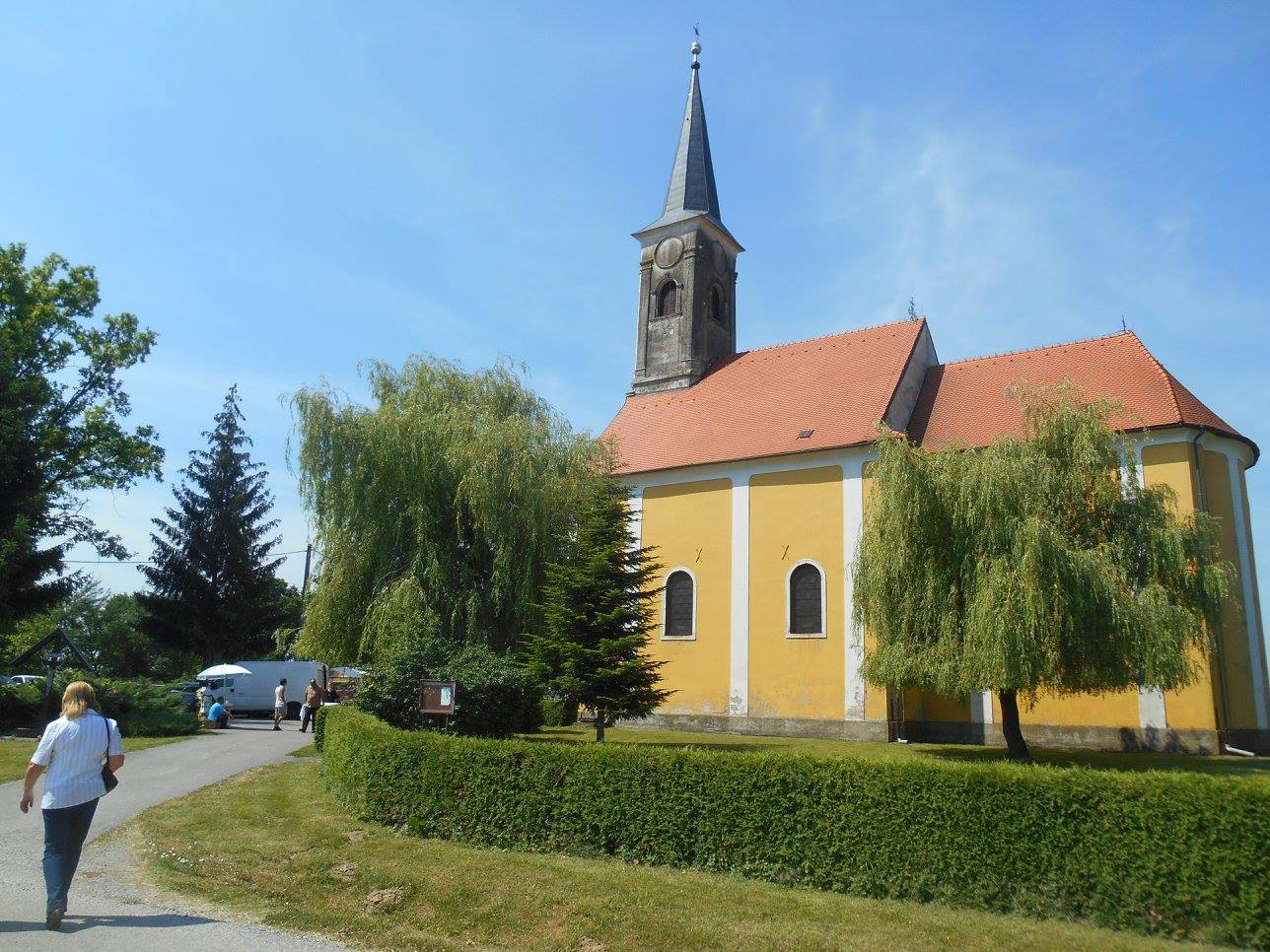
Ta je crkva ovako izgledala samo 24 sata ranije. Kasnije sam saznao da je orguljaš čistio orgulje u crkvi kada je krenuo najjači potres, te je tragično izgubio život u crkvi.
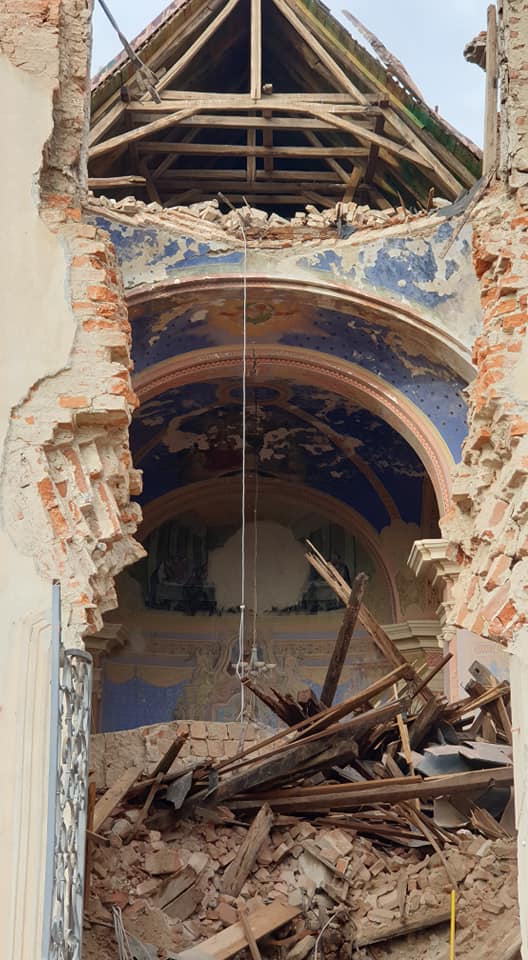
Freske na zidovima u unutrašnjosti mogle su se i dalje vidjeti.
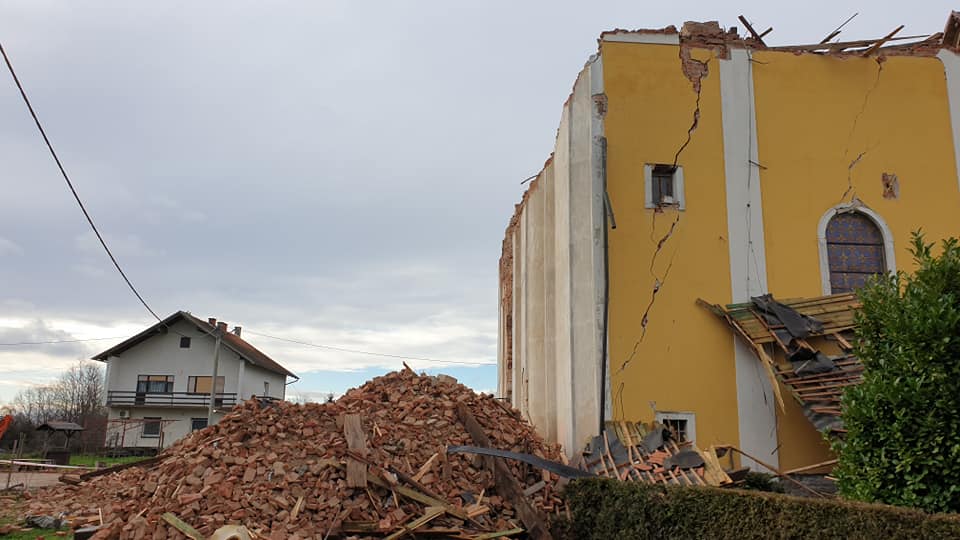
Novije protiv staroga, jer je susjedna kuća prošla bez oštećenja. Ali kao što smo vidjeli u Gori, to što je zgrada novija ne znači nužno da je sigurna od potresa.
Vraćali smo se u Zagreb u relativnoj tišini, svaki izgubljen u svojim mislima, trpeći posljedice ranog ustajanja i trauma koje smo vidjeli taj dan.
Težak je to bio dan, sasvim sigurno, ali i ugrijao nam je srca. Hrvati su najotporniji ljudi koje znam, a teškoće u njima bude najbolje. Postoje tisuće herojskih primjera svaki dan u ovom trenutku i plješćem svakome od njih koji je preuzeo na sebe dio odgovornosti.
Nemojmo zaboraviti ni velikodušnost dijaspore i međunarodne zajednice. Odgovor na ovu katastrofu zaista je impresivan, kao što je bila i hitna reakcija. Oni koji trebaju pomoć zaista je i dobivaju, a donacije svakako pritom pomažu.
Za više podataka o potresu u Petrinji pratite današnji članak s najnovijim vijestima. Da biste saznali kako možete donirati novac, hranu, građevinski materijal i humanitarnu pomoć, kliknite ovdje i ovdje.
Interview: HGSS Croatian Mountain Rescue Service in Petrinja
December 31, 2020 – Croatian firemen, army, police and medical workers worked through after the earthquake in Sisak Moslavina County on 29 December 2020. We wanted to get a sense of the demand on and the experiences of emergency services, so we spoke with Josip Granić. Head Of Service for HGSS, who was coordinating the efforts of the Croatian Mountain Rescue Service in Petrinja
This interview took place in Petrinja, just before 12.30pm on Wednesday 30 December 2020
Right now we have around 120 people here. Last night we sent some home. During the height of the operation, we had 192 members of the Croatian Mountain Rescue Service in Petrinja and the surrounding towns and villages. Firefighters and police from all over Croatia came. There are more than 200 army personnel here too.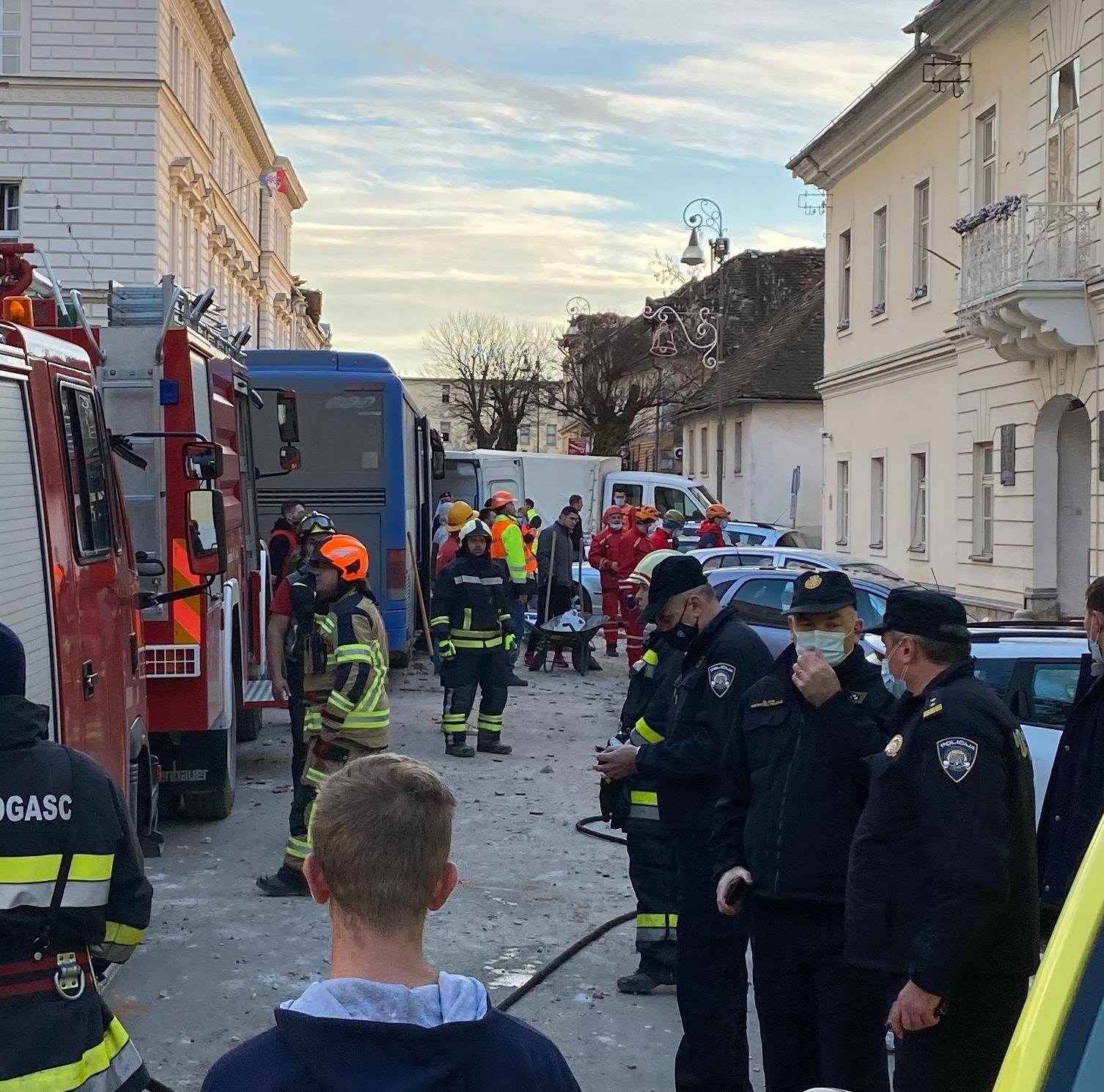
Because we are part of the operational team of the National Civil Protection, we were already here and involved in the response to the first earthquake. After yesterday's earthquake, I called each HGSS station across Croatia and asked them to prepare at least one vehicle and one team to come and join the Croatian Mountain Rescue Service in Petrinja. The first extra teams to arrive were from this county - Sisak and Novska. They got here around 2pm. Teams from Orebic, Peljesac and Split arrived maybe last, because of the large distance they had to travel. One team came by car, another came by helicopter.
What was the situation like for Croatian Mountain Rescue Service in Petrinja when the wider team first started to arrive after the second day's larger earthquake?
If I said it was chaos, that wouldn't be strong enough a word. The centre of the town was chaos. Everyone was busying themselves with responding – people were moving debris, firefighters were making their way through, ambulances and police moving through, people of the city in the streets helping out. The streets were filled with dust and smoke. You could hear the sounds of floors and roofs and buildings collapsing all around you.
What were the first undertakings for the Croatian Mountain Rescue Service in Petrinja?
Well, our first response was not only in Petrinja – we were immediately in some of the surrounding villages too. The very first thing we did was send in our search teams and the specially trained dogs we work with. We were instructed by locals. They told us which of the collapsed buildings were likely to have people trapped beneath them. We immediately found one person. It was in the town hall. One lady. The entire ceiling had fallen on top of her. Our colleague from Ogulin found her with his dog. The firefighters worked so fast, so hard to dig her out. They were excellent. It took four and a half hours to get her out. She was lucky. Unfortunately, we also found four more people who were already dead.
We saw quite a lot of volunteers. Who is organising them?
There are many different groups. Many local people were the first ones out on the streets, volunteering. Then, those from the immediate area came - four friends in a car, that kind of thing. |NGOs arrived next – veterans, charities and so on. Then, football fans from all over Croatia arrived. Supporters groups had organised coaches to bring themselves here. At first, nobody was organising them and it was a bit of a problem. They organised themselves. But, it was such chaos that some emergency vehicles, including search and rescue teams of Croatian Mountain Rescue Service in Petrinja, could not pass through the town. This is dangerous because, in search and rescue, your ability to respond quickly is vitally important. After dark, things began to run more smoothly. Many worked until 3am or 4am, then they were sent home. The ones who didn't arrive until much later in the night were incorporated into Civil Protection and assigned to work the next day in villages and towns outside Petrinja, where help was needed.
How has the demand on what you do changed since yesterday?
It hasn't changed that much. We have been visiting villages throughout the county as quickly as we can, searching for people who may be trapped. Some of these places have not yet been reached by the other emergency services, but they will get to them. We found another alive person who was trapped today. Since early in the morning we have searched 84 villages.
What advice would you give someone who wants to come here to volunteer?
Organise it first with Civil protection. If it is organised with them, then you know you won't be in the way and you will be going to where help is needed. If it's organised with them first, then come. There's a job for everyone who wants it here.
How different is the demand on emergency services in this earthquake compared to the earthquake in Zagreb in March 2020?
Well, our services were not requested during the Zagreb earthquake and a lot of that is because of the structural integrity of the buildings in Zagreb. Most were strong enough to survive that big earthquake. The ones which were damaged were only partially damaged. Many buildings in Zagreb were hardly damaged at all and so many people in Zagreb were relatively unaffected by that earthquake. Here, everyone is affected.
All images © HGSS
Majske Poljane Video Reports Show Extent of the Earthquake Tragedy
December 31, 2020 - The Croatian media has published various Majske Poljane videos showing the scale of destruction, tragic loss, and a miraculous escape.
I knew that visiting the scene of the Petrinja earthquake was going to be traumatic, but I am glad that I did. Apart from helping me understand the realities on the ground better, I hope the report has been informative for the many people wanting to help Croatia in this time of national tragedy. You can read Majske Poljane, Glina, Petrinja: A Foreigner View of Croatia's Emergency Response here.
Nowhere was more devastated than the first place we visited, Majske Poljane. Without the resources or connections of the mainstream big Croatian media, it was always going to be hard for me to get the full story. Reading through the various accounts and watching videos from my Croatian colleagues has recorded events and human stories in a way that I could not. Here are a selection of Majske Poljane videos from the aftermath, with their YouTube commentary translated below. The most shocking realisation from watching these videos is finding that the first house we visited - with the ten shell-shocked horses - was the house where four people were tragically killed.
It is cold in Majske Poljane. Clouds hovered over the village, which no longer exists. No one reacts to constant tremors anymore. Silently, with dark circles under their eyes, calm men clean the remnants of their former lives. Five locals were killed. Dario Tomić, the son of the deceased Franjo and the brother of the deceased Marija, raises a photograph of his family from the ruins. The whole house fell on them, there was no salvation for them. Dario folds the photo, the only one left for him after this horror. He has no tears, he is strong, he sticks to the rest of the family, to the mother who survived.
Majske Poljane - The village in the Glina area that suffered the most in the earthquake. Borislav Meandđija came out a second before the earthquake to go to the city to get a credit card. That second was enough to save his life, as the house behind him collapsed to its foundations.
The village of Majske Poljana near Glina that suffered the most in the earthquake. A strong earthquake hit Croatia yesterday, the epicenter of the 6.2 magnitude earthquake was 3 kilometers from Petrinja. The Croatian Mountain Rescue Service and search dogs on the ruins of the house where father and son Tomić were killed yesterday
HINA also recorded its observations.
The nearby town of Petrinja from the air.
Find out how you can donate here.
To follow the latest TCN coverage of the earthquake and its aftermath, follow our dedicated section.
PHOTOS: Majske Poljane, Glina and Petrinja One Day After The Earthquake
December 31, 2020 – Total Croatia News visited Majske Poljane, Glina and Petrinja one day after the earthquake. It is difficult to find words to describe the devastation we saw. Perhaps pictures tell the story better
Majske Poljane

Majske Poljane is a rural community. Such was the devastation here, it was difficult to tell which of the destroyed buildings had yesterday been used for agriculture or if they'd been homes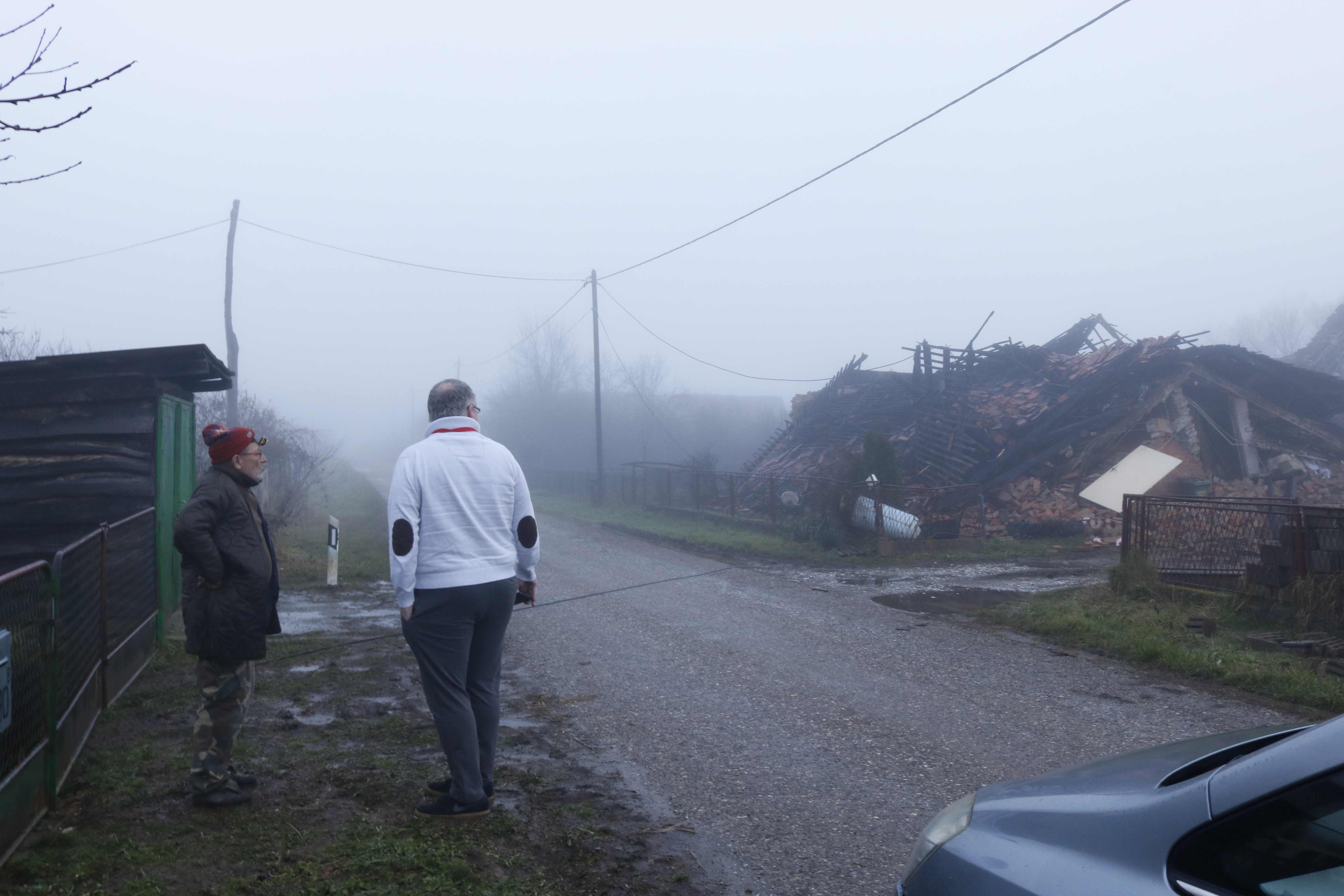
TCN's Paul Bradbury talks to Majske Poljane resident Vladimir who confirmed that, yes, the building across the lane had been a home, his neighbours had lived there just 24 hours earlier
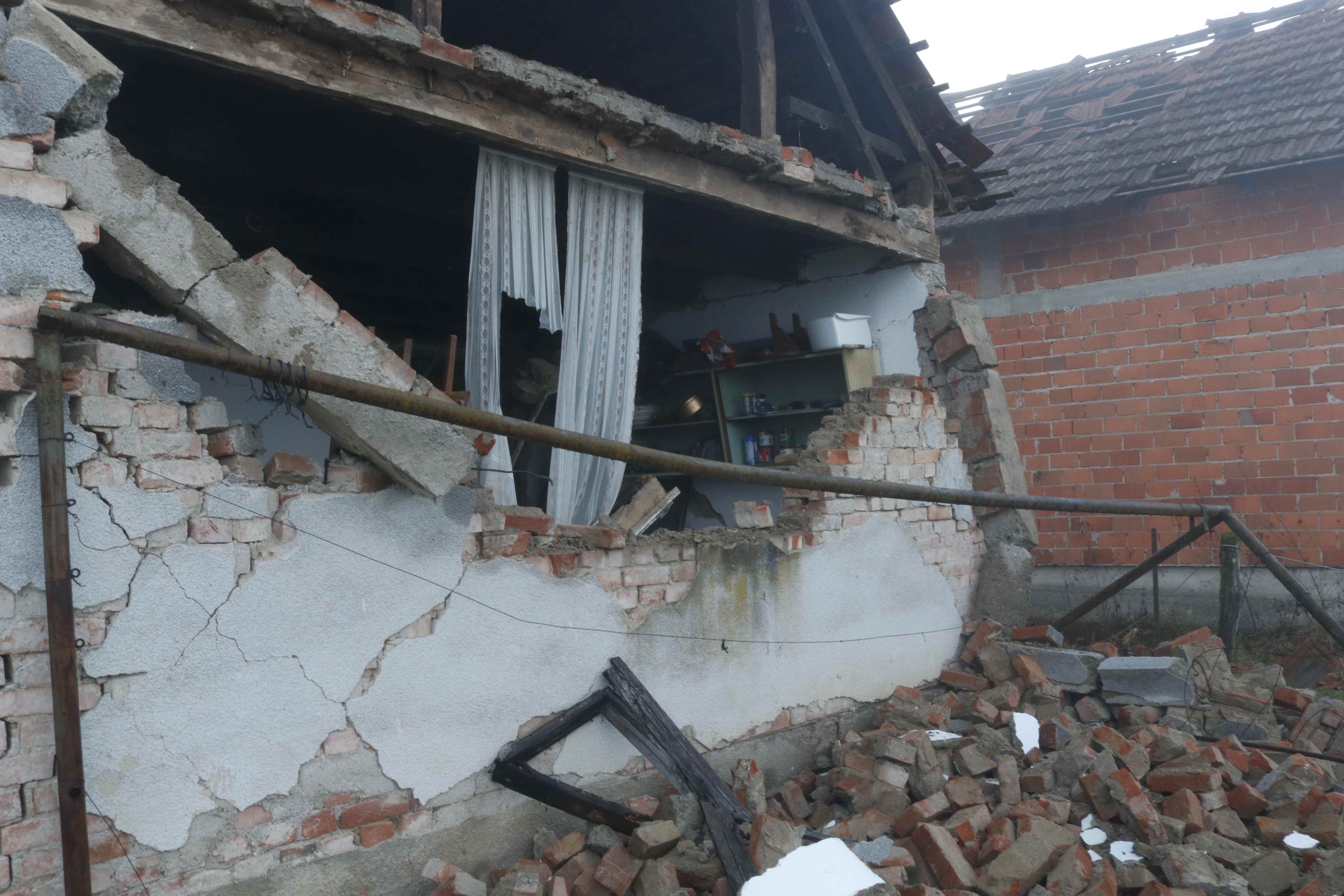
Doors of houses left ajar, windows collapsed, smashed and broken. Inside, you can see everyday lives, stopped suddenly, frozen in time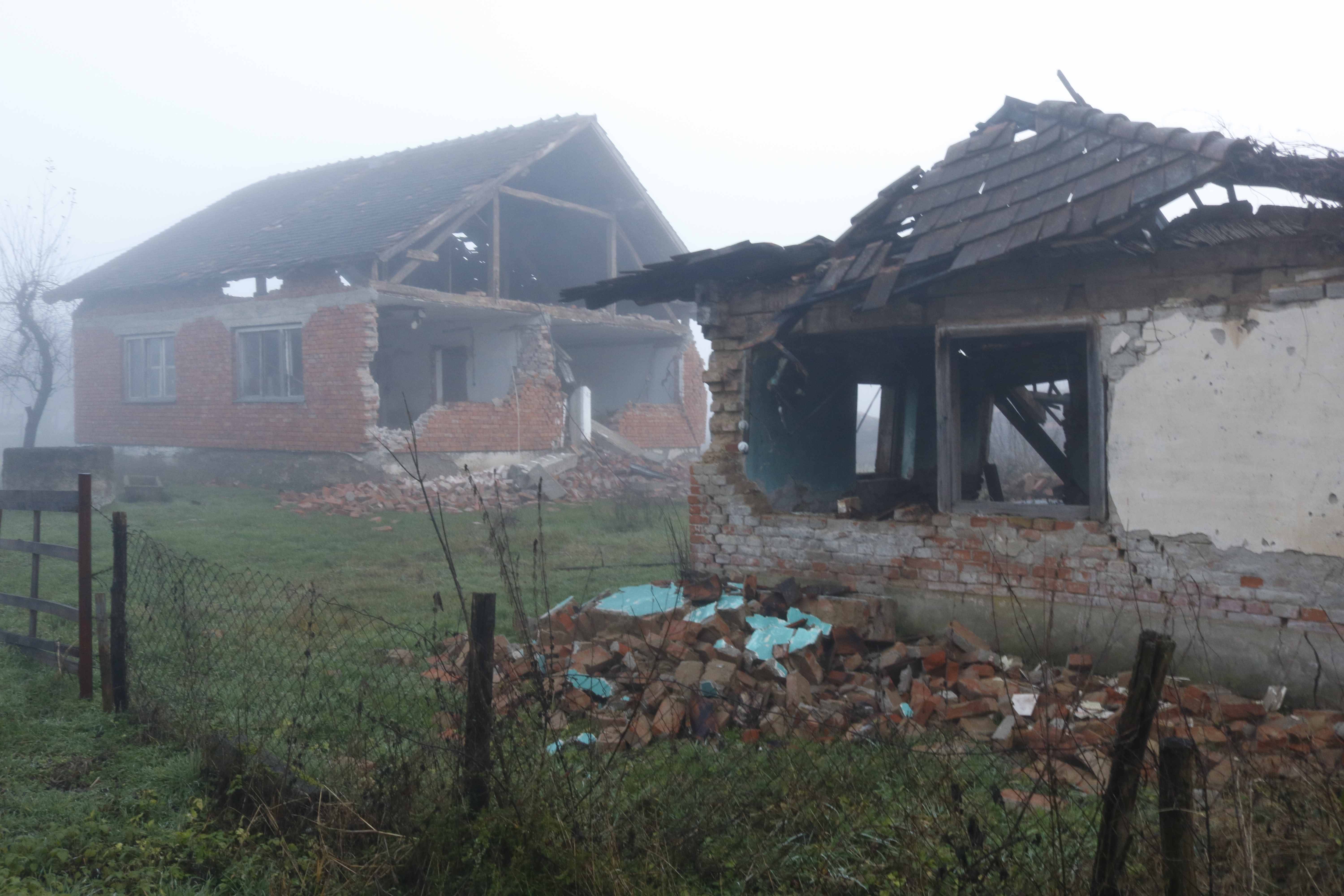
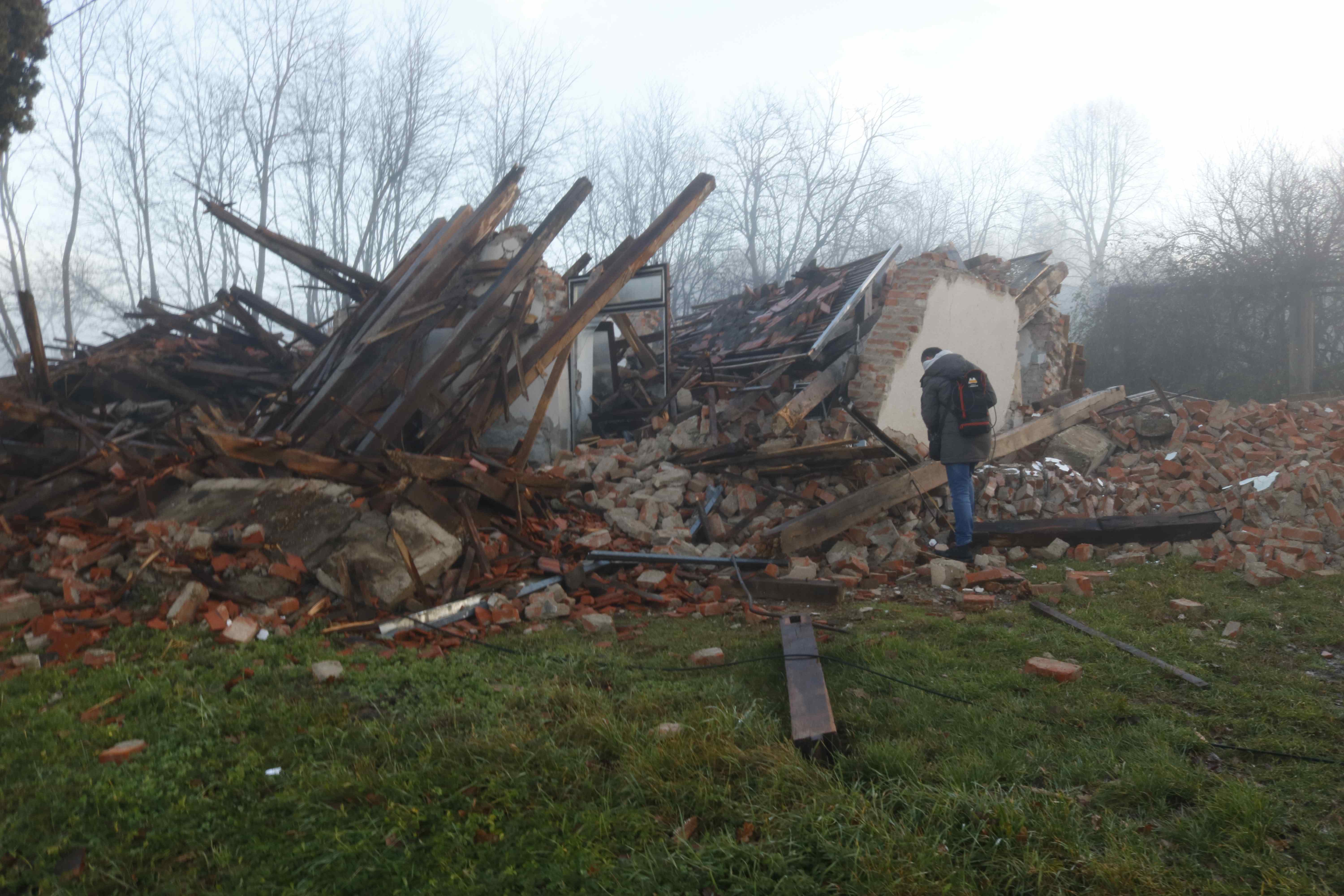
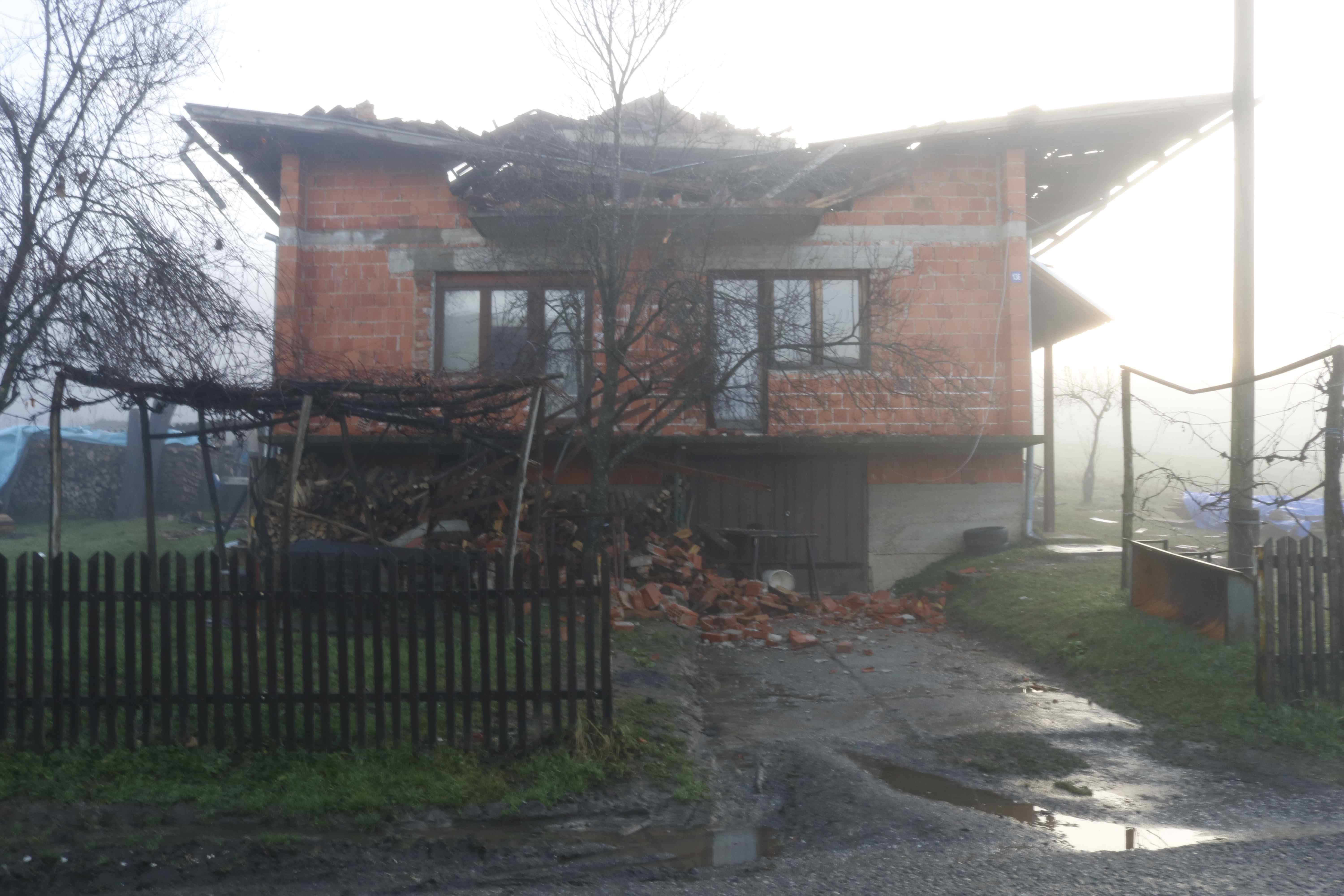
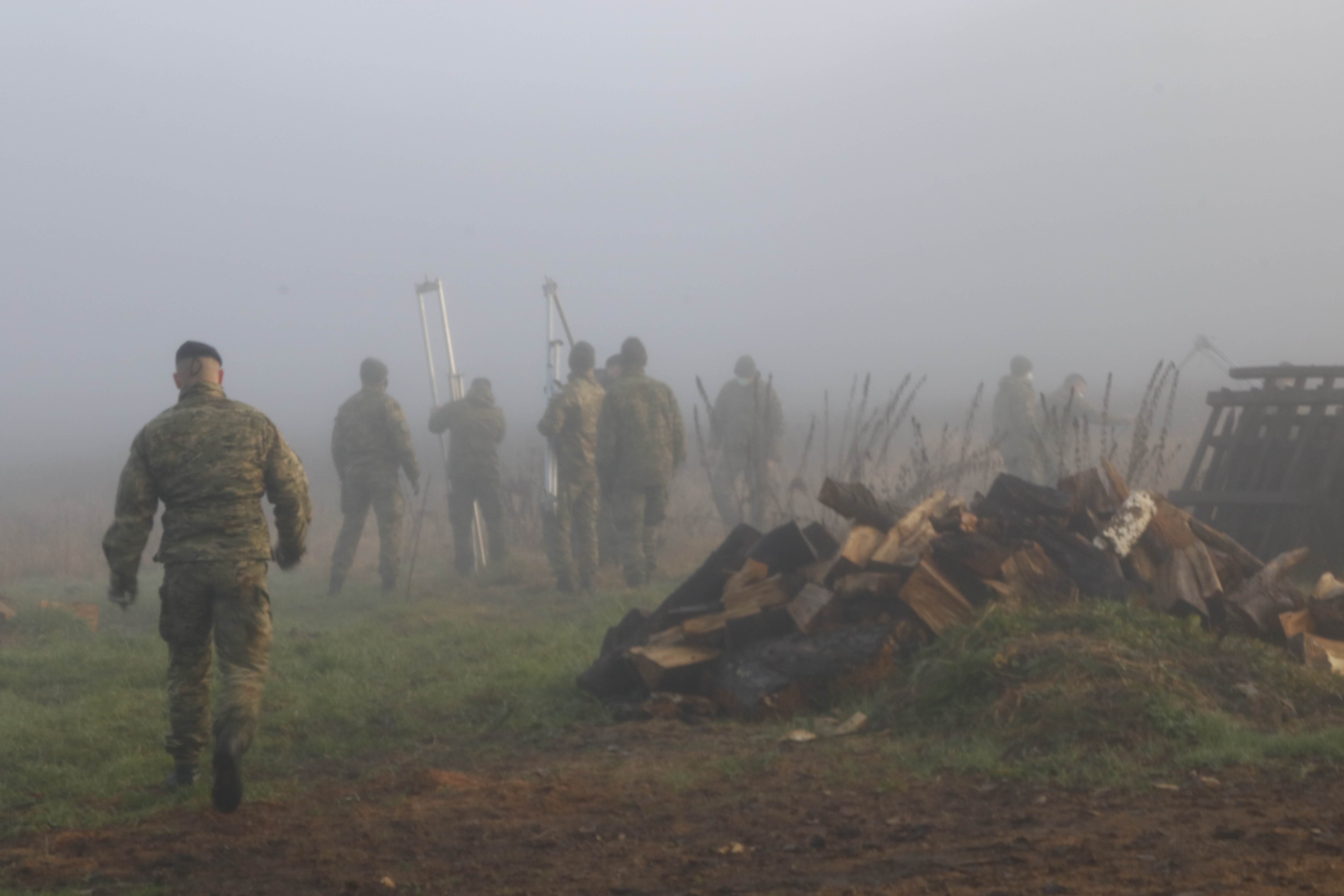
Croatian soldiers quickly constructing emergency shelters in the freezing fog of early morning. They came from all over Croatia. Unsure if their damaged houses were structurally safe, parents and children of Glina, surrounding villages and Petrinja stood in gardens and fields, keeping warm around fires. With no electricity, they cooked on barbecues.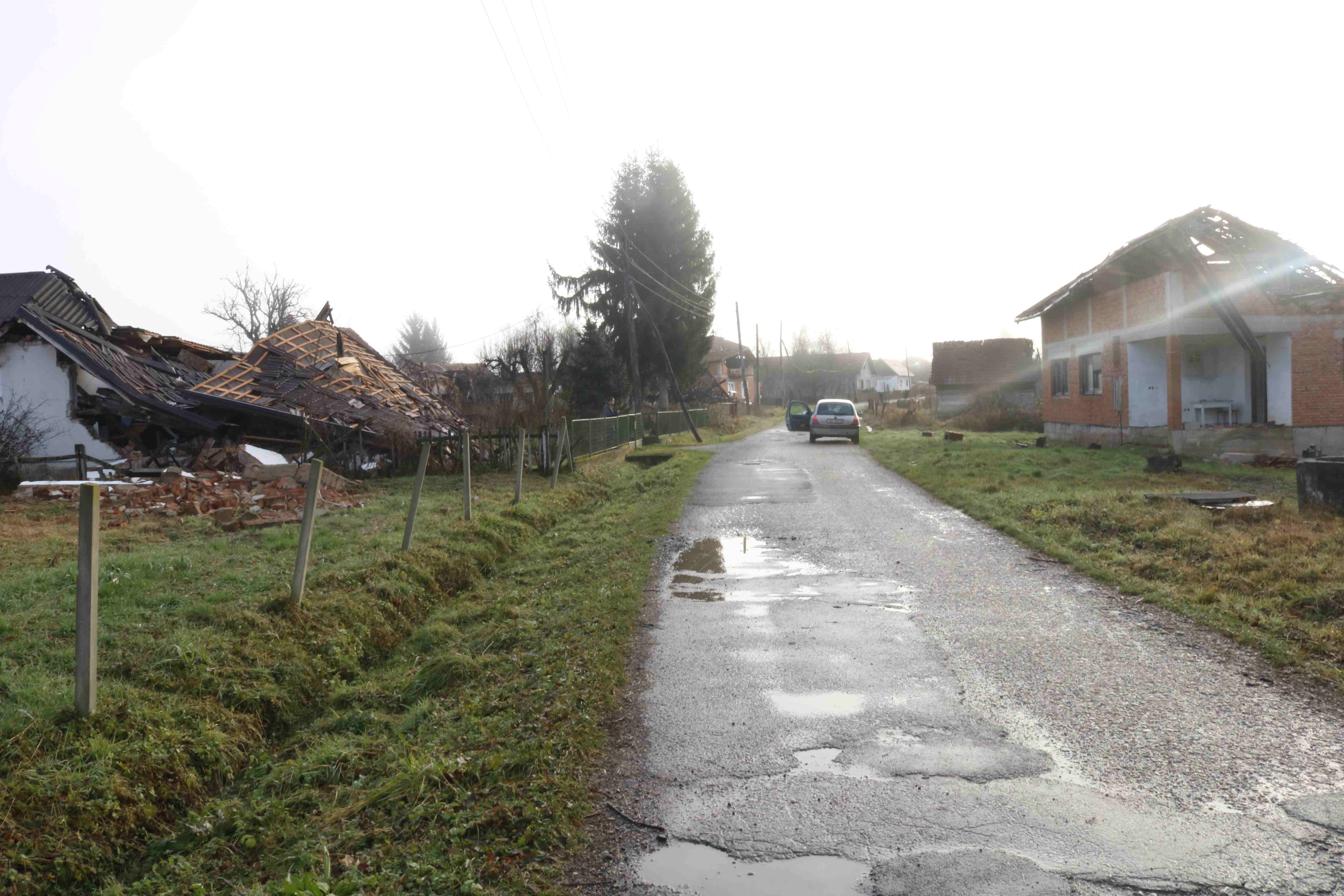
Majske Poljane seemed like the most silent place on earth. No single sound, not even bird song.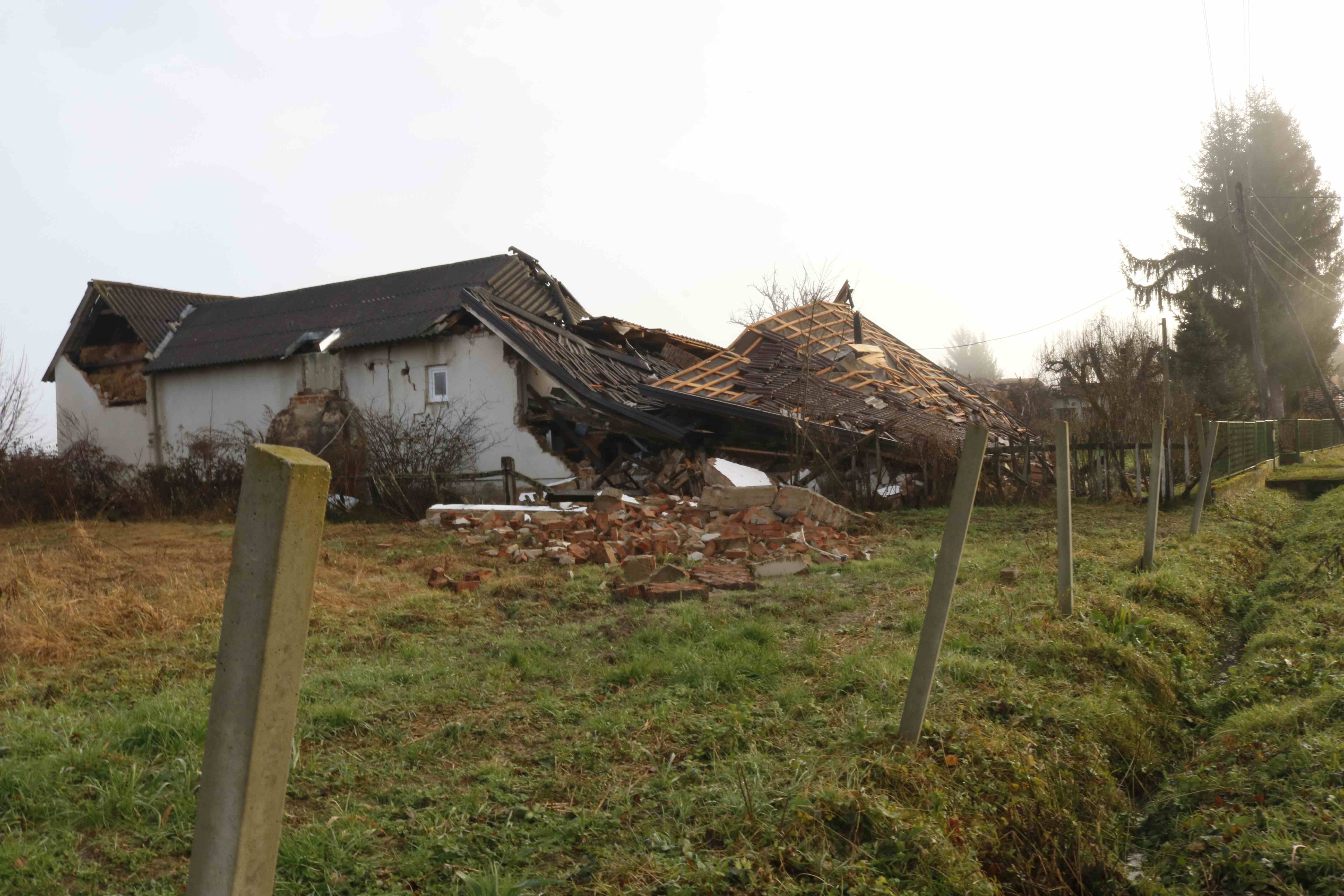
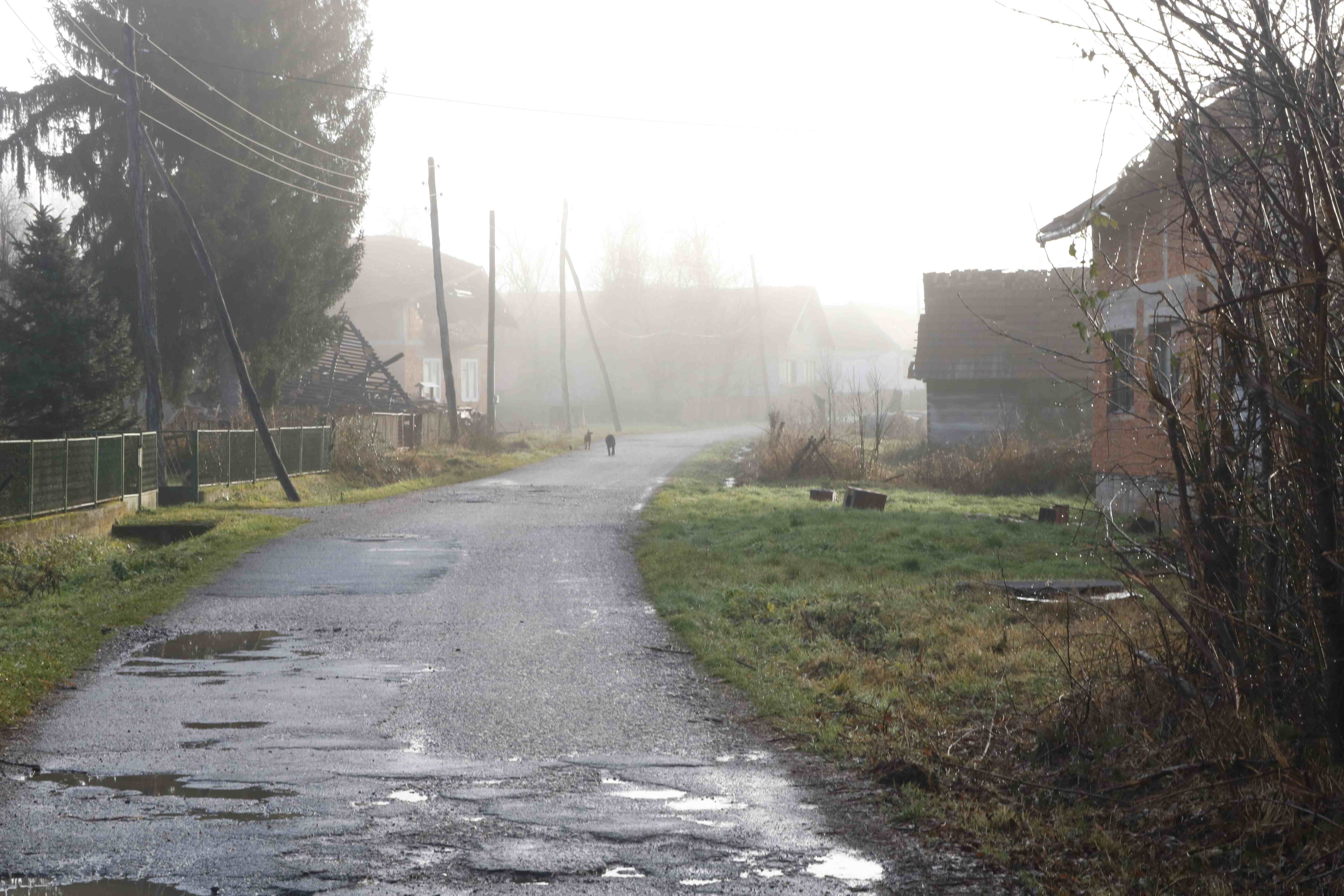
Even the three village dogs left behind padded around the wet road in silence
Glina

Croatian firefighters walk heavily through the mist-filled streets of Glina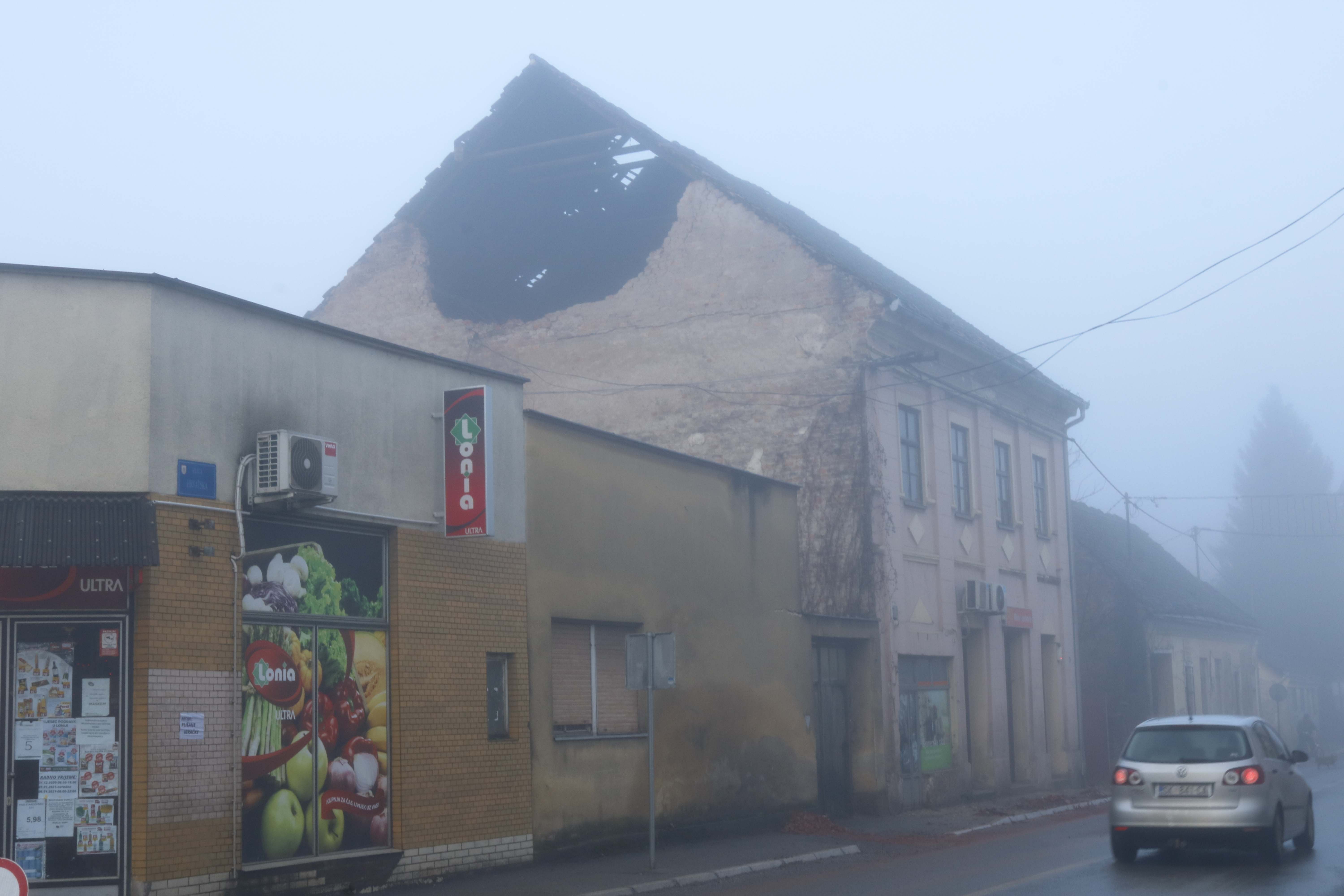

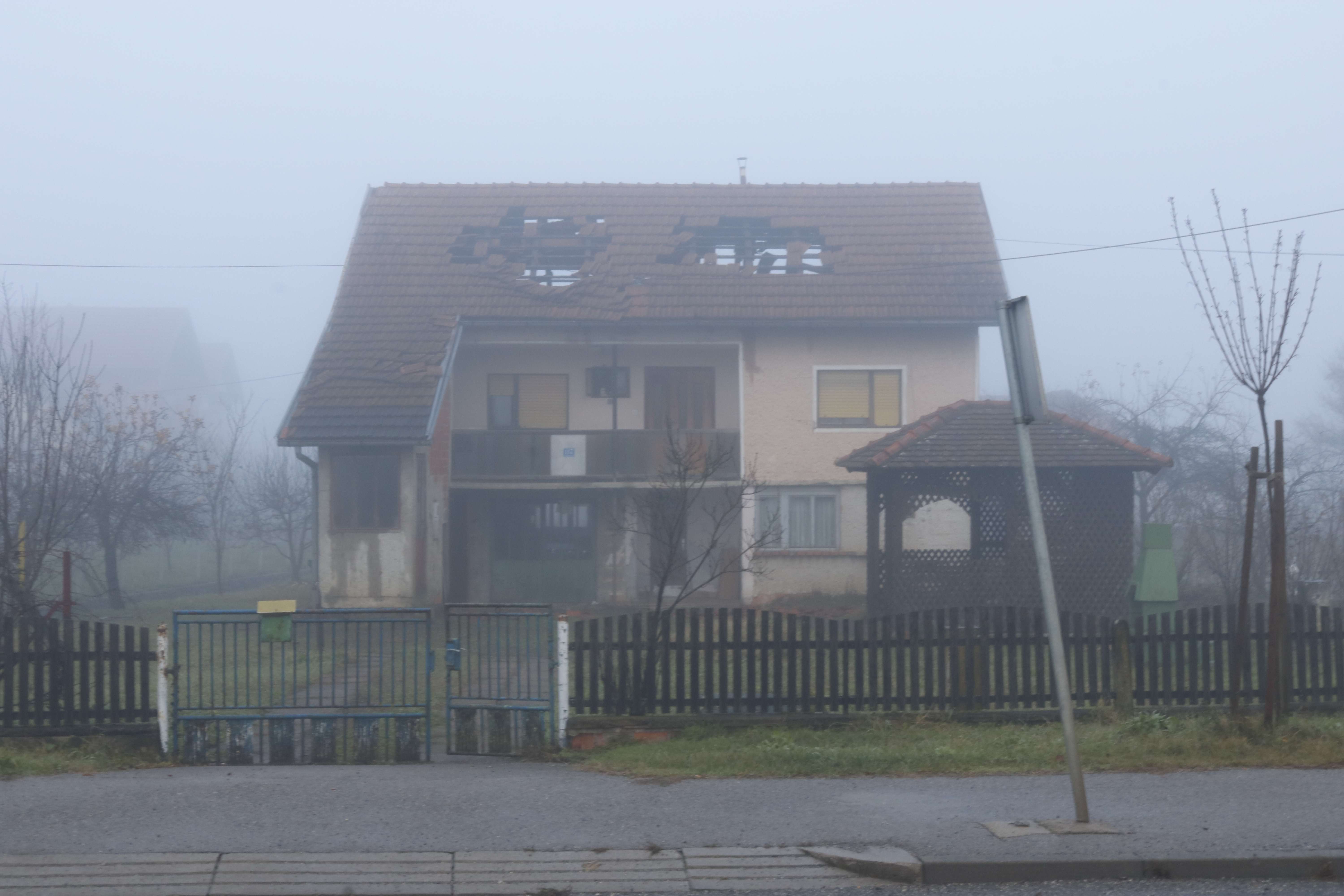
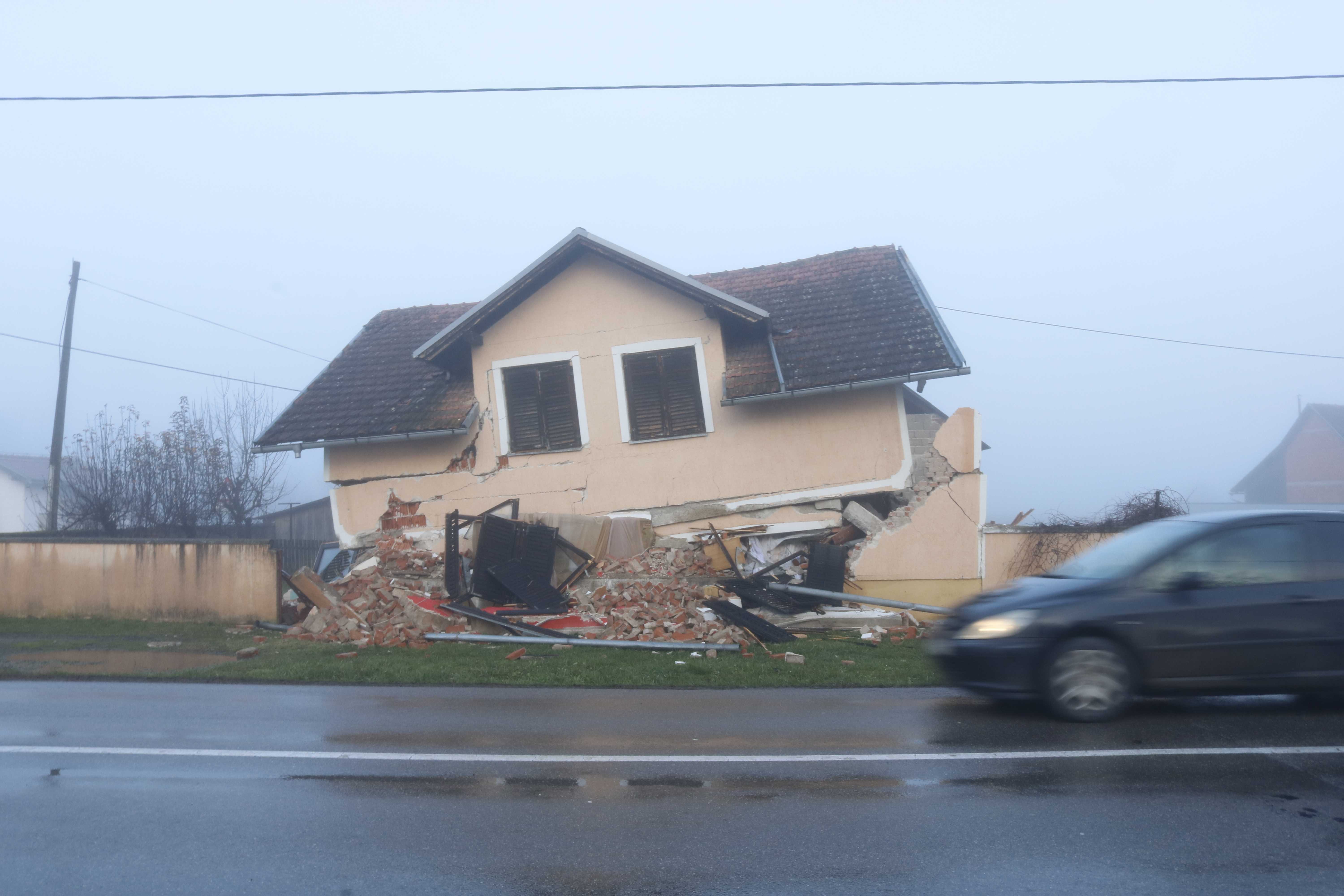
The entire upper floor of this house had collapsed, crushing completely the floor underneath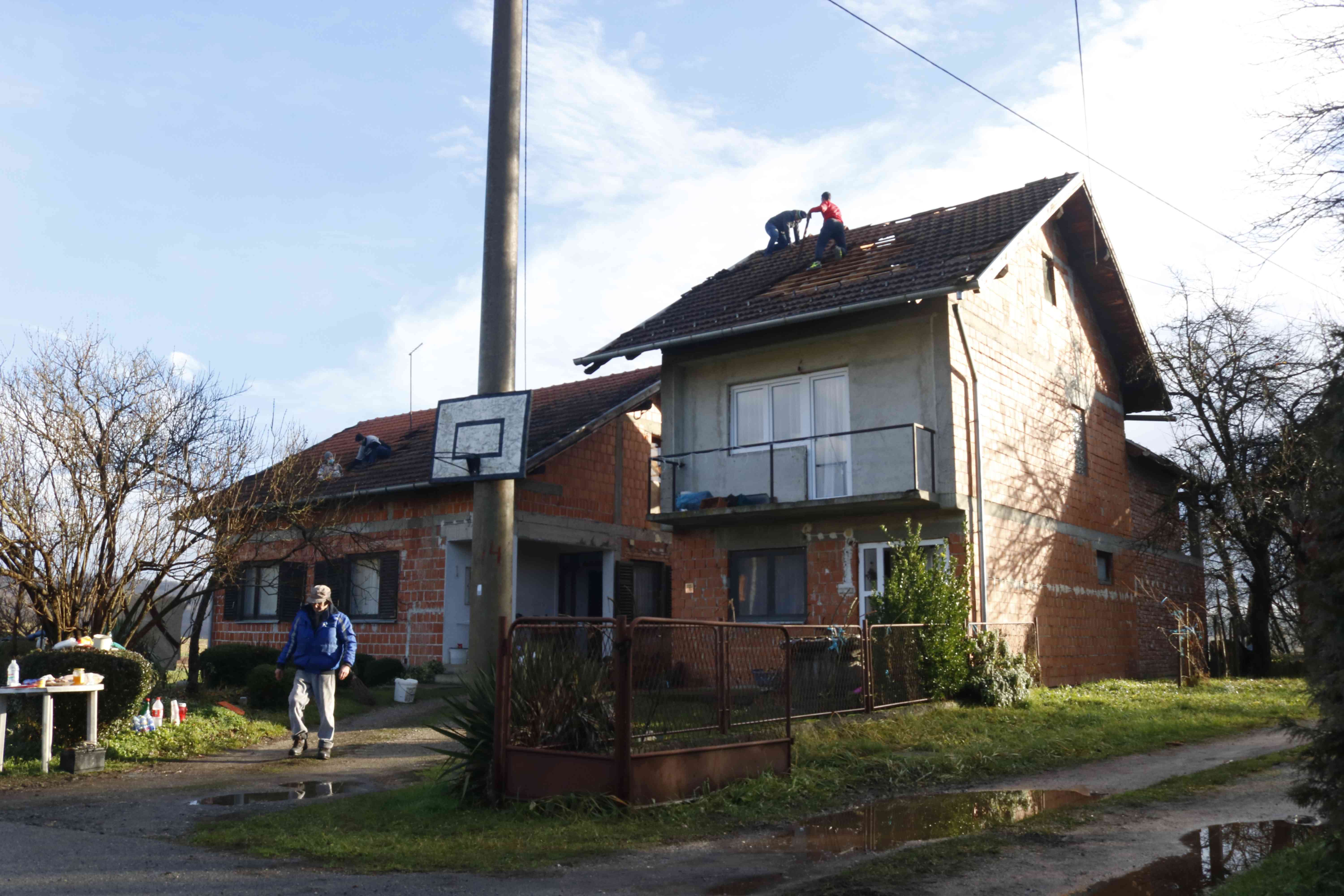
Volunteers at work on the roofs of two neighbouring houses, between Glina and Petrinja one day after the earthquake. The volunteers had come from all over Croatia
Petrinja one day after the earthquake

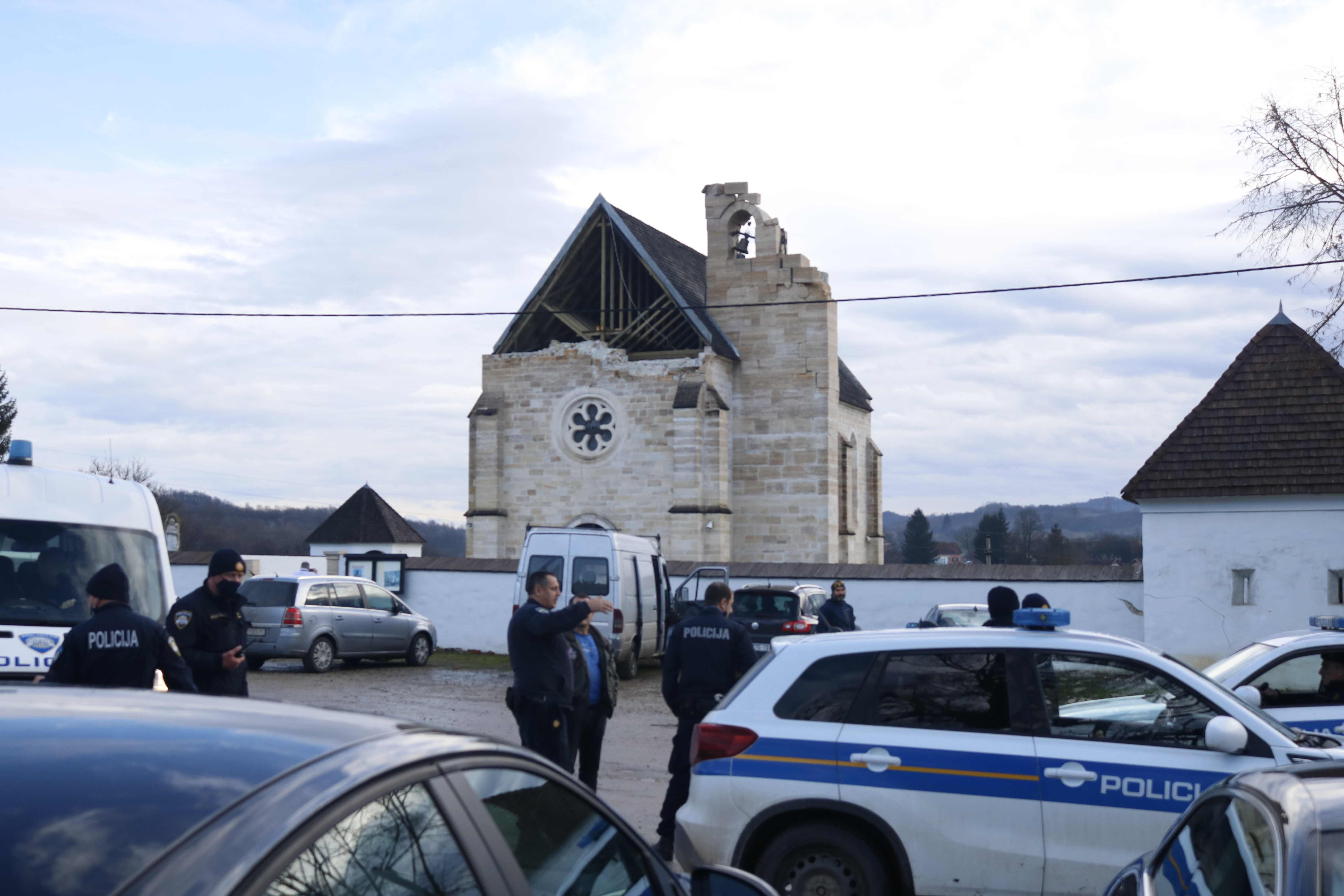
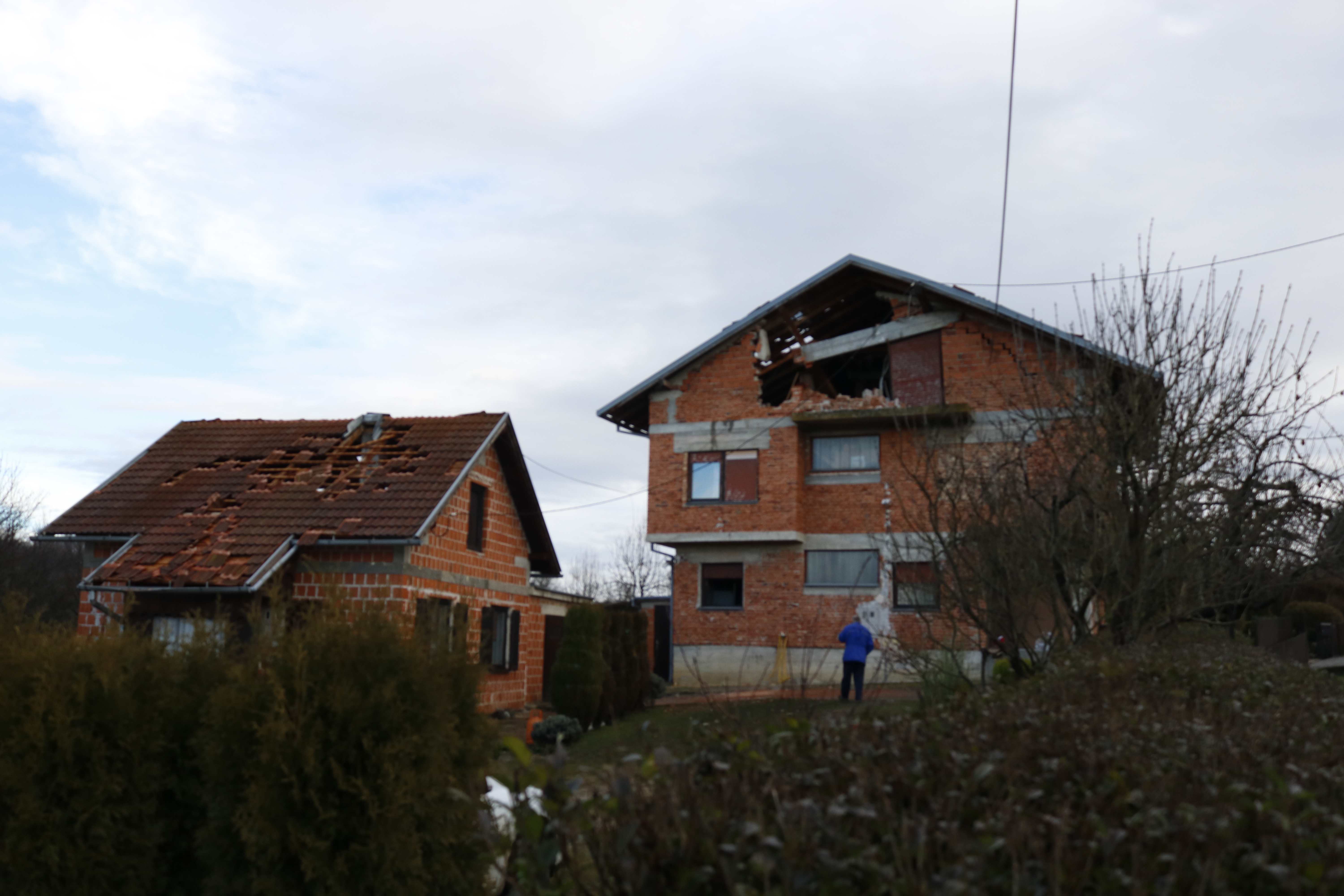

Even in the miserably wet winter weather, the greeting sign to Petrinja one day after the earthquake might still have looked cheery, if you couldn't see all the emergency vehicles in the background. 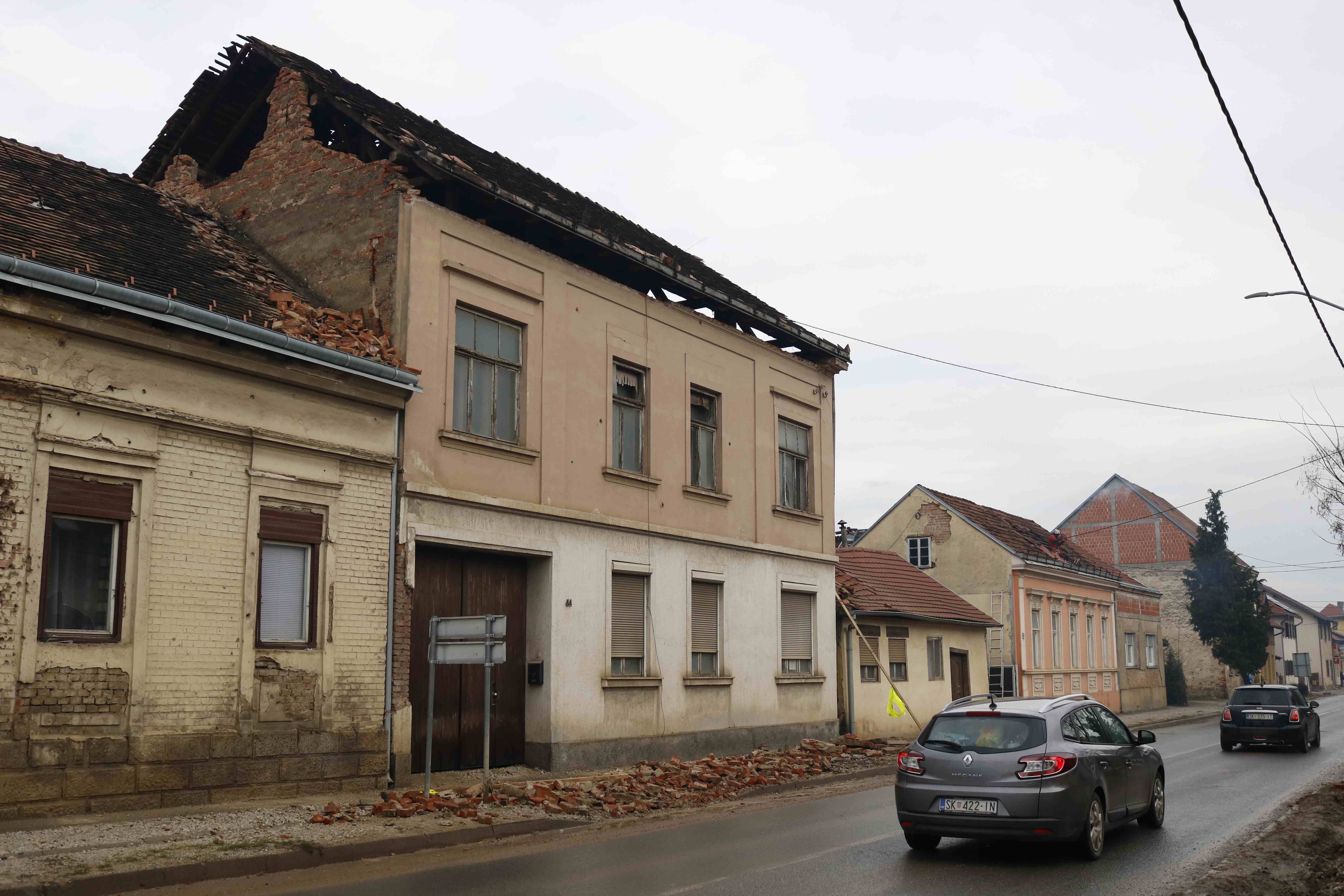
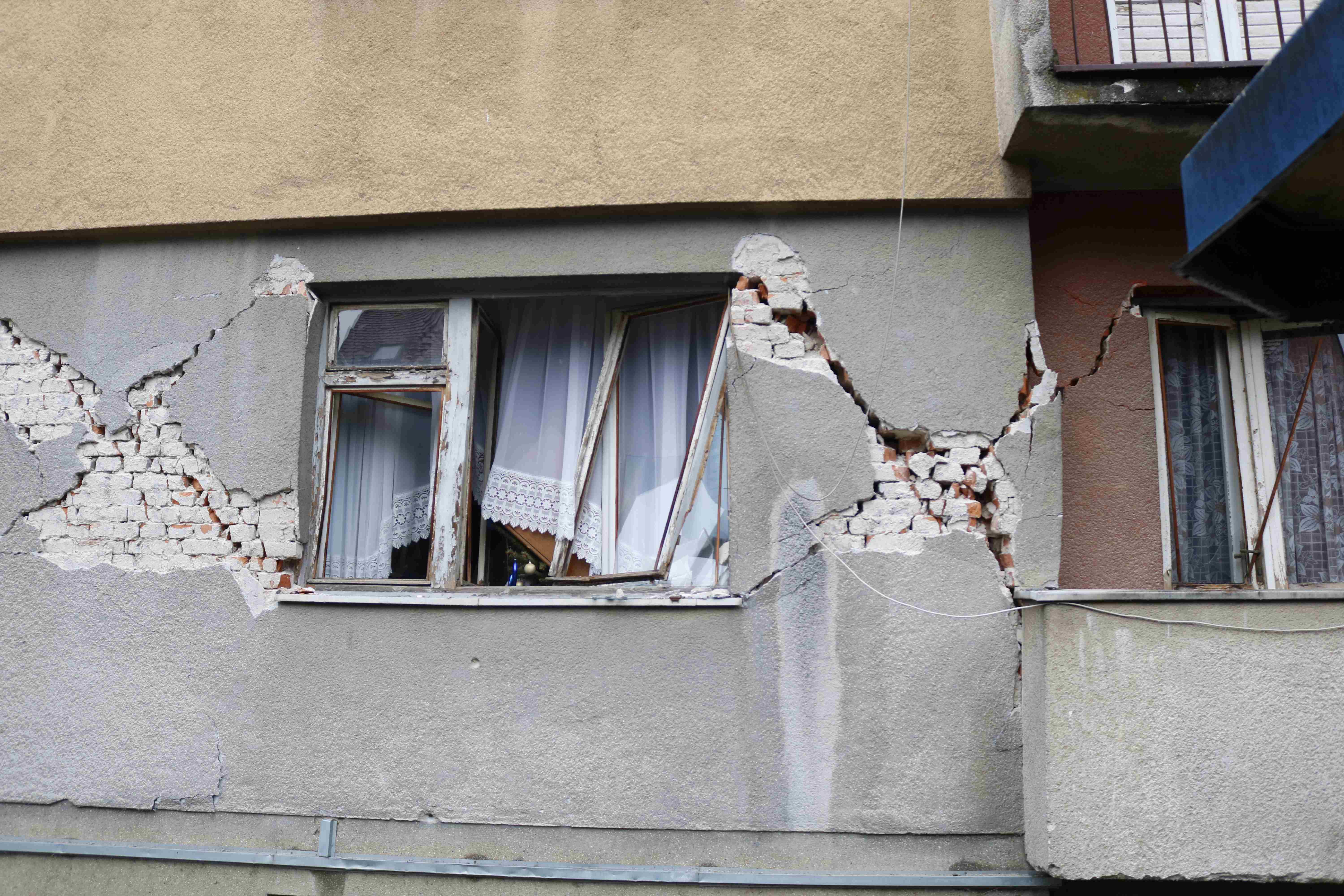
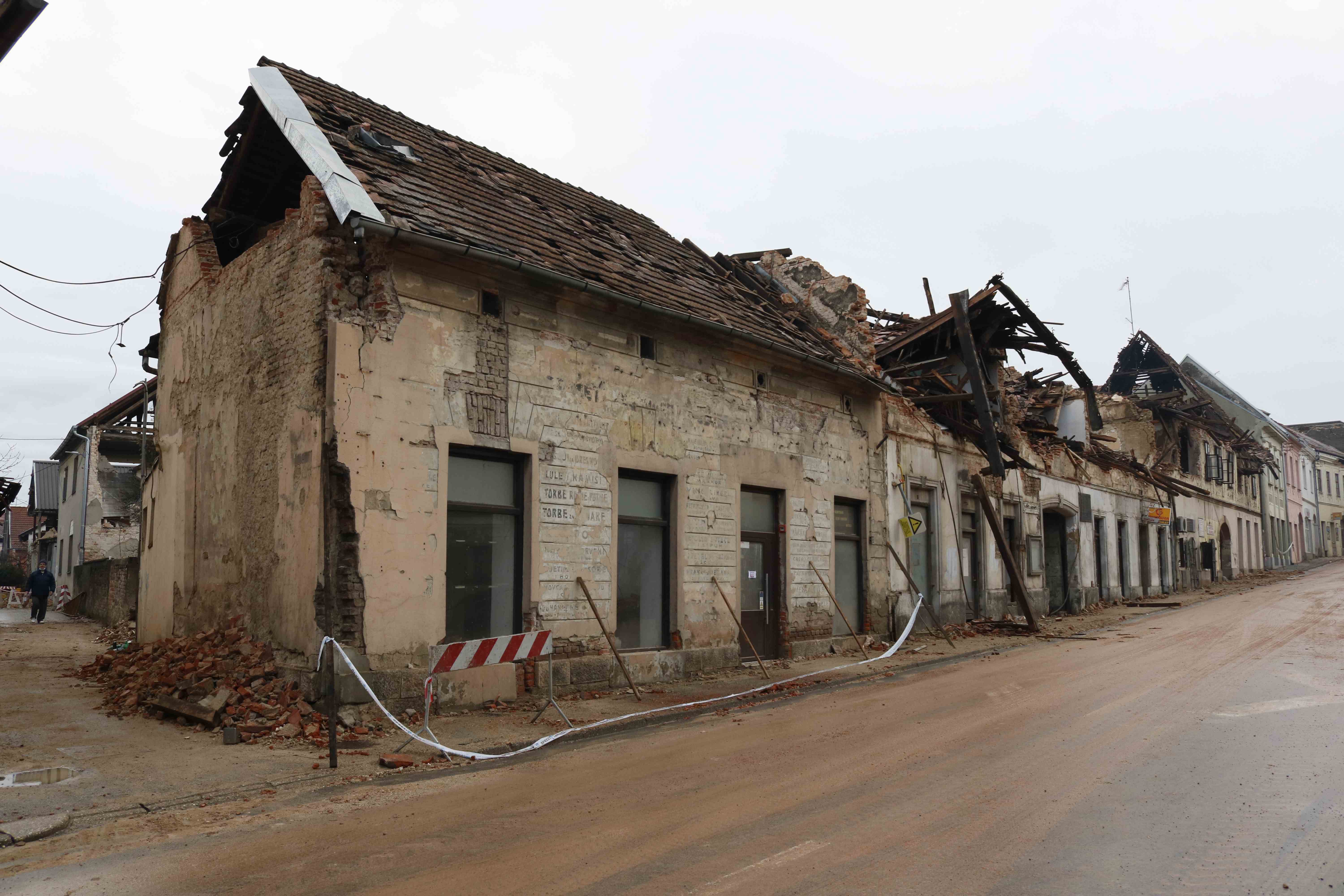
If you didn't know any better, these might look like damaged derelict buildings. But, 24 hours earlier, these had been a row of thriving storefronts, right in the centre of Petrinja one day after the earthquake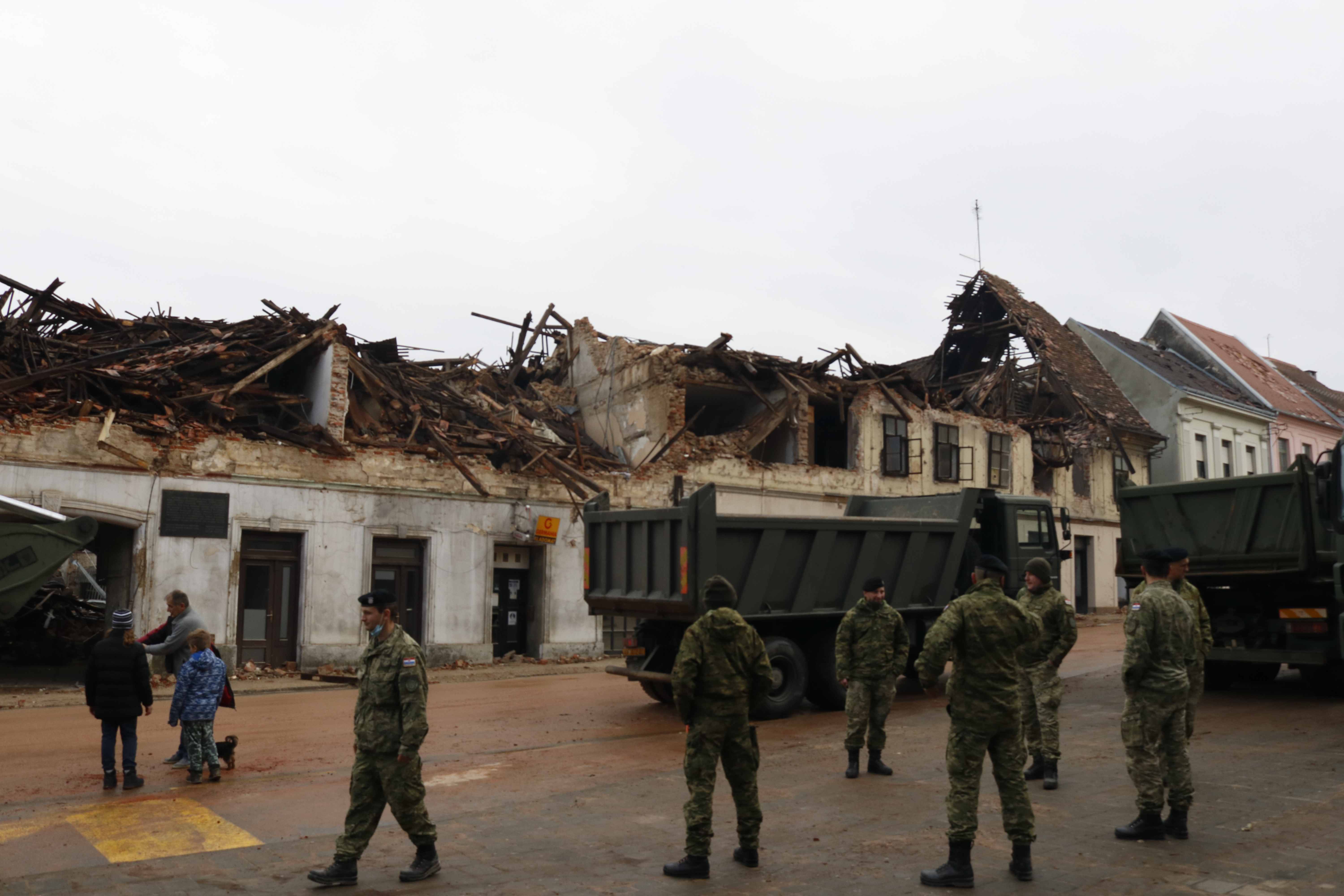
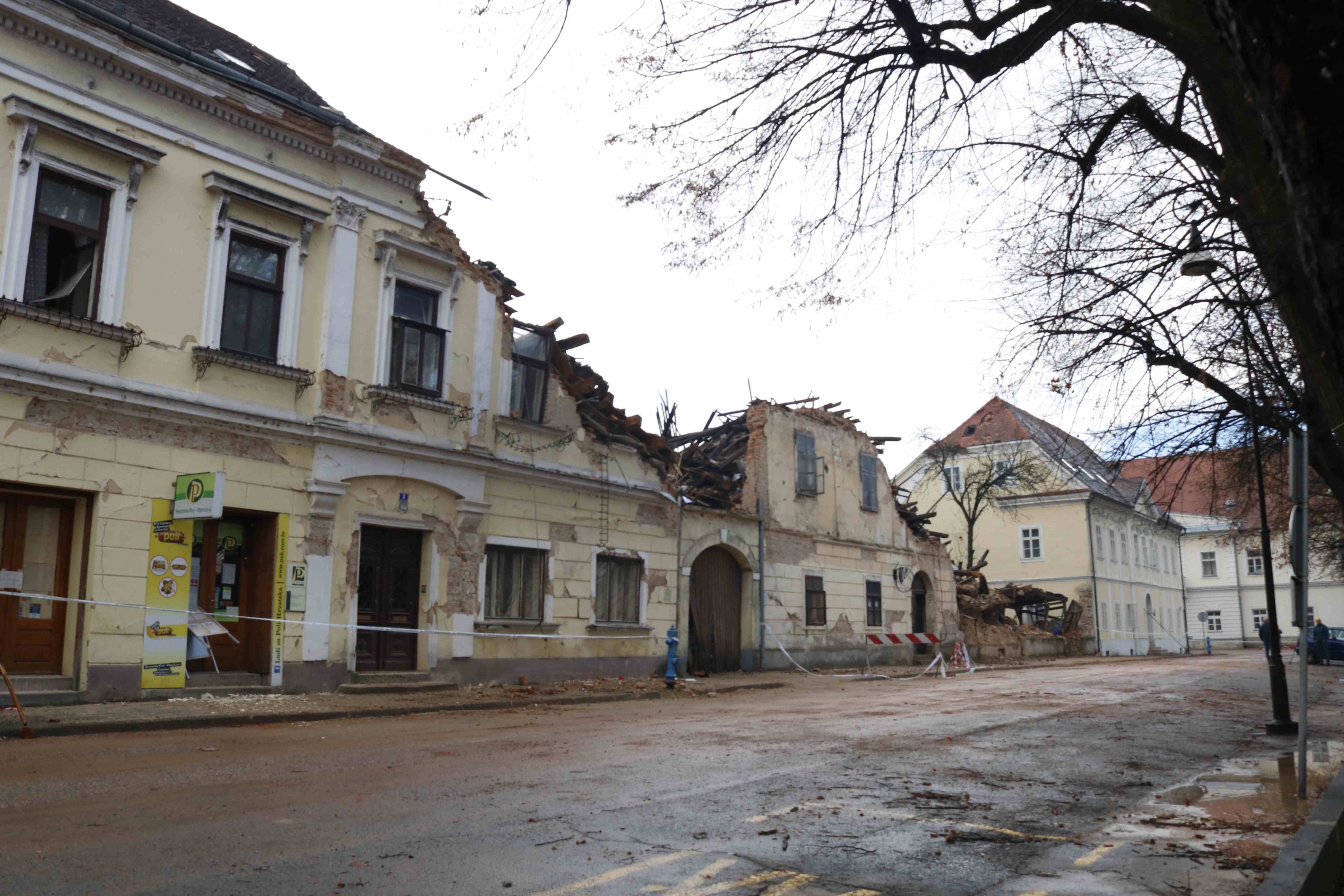

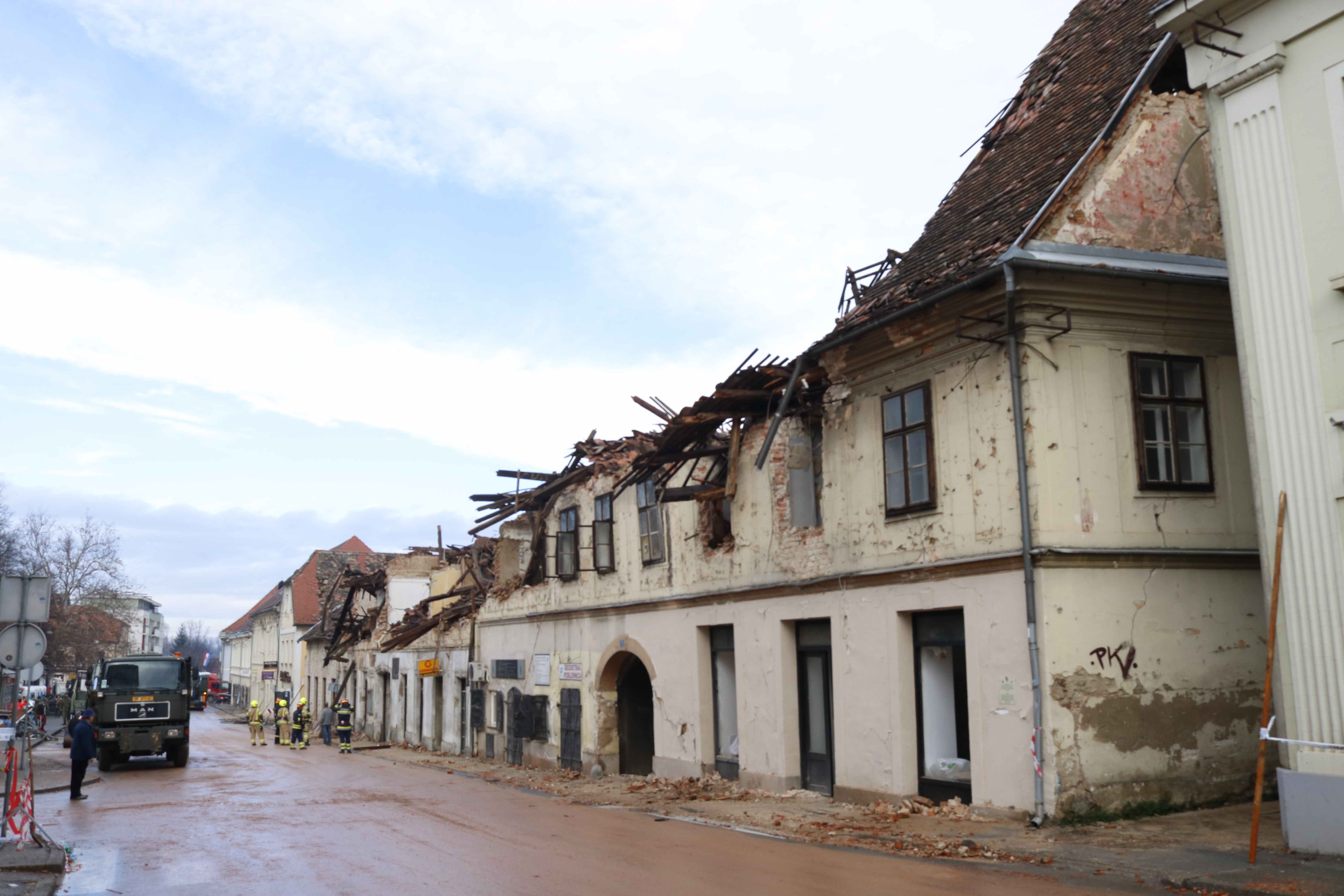
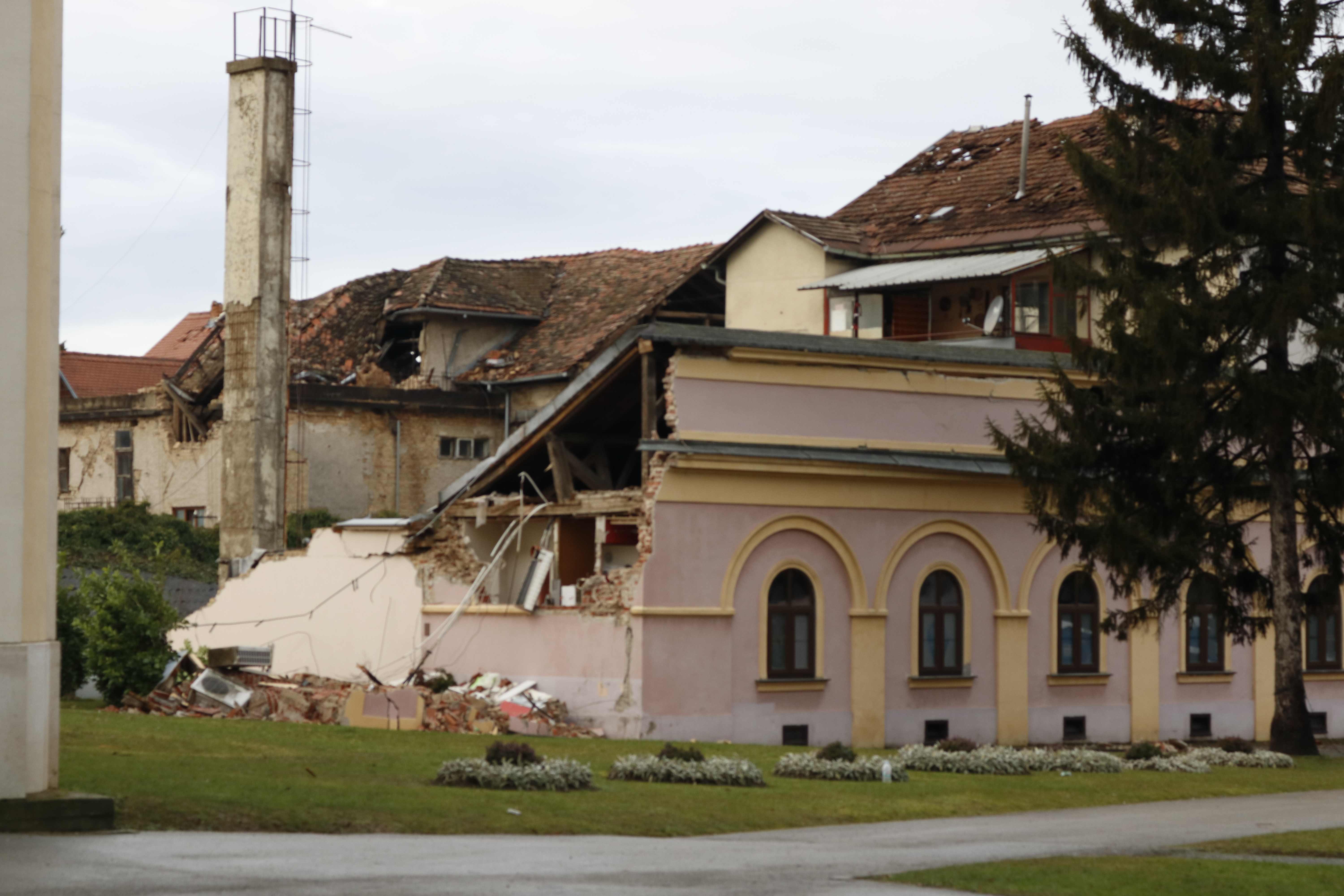
Sisak

Damage to the train station in Sisak. A considerably larger city than Petrinja one day after the earthquake, not one business we passed was working - no supermarkets, no fast-food restaurants. Nothing. Groups of teenagers roamed the streets with nothing to do and nowhere to go
Zazina

The Parish church of St. Nikola and Vida, Žažina near Petrinja one day after the earthquake
This is how the church had looked just one day earlier. A couple of metres from the church, remnants of the fire that parishioners had gathered around on Badnjak (Christmas Eve). We later learned that the church organist had been cleaning the organ when the earthquake struck, and tragically he was killed. 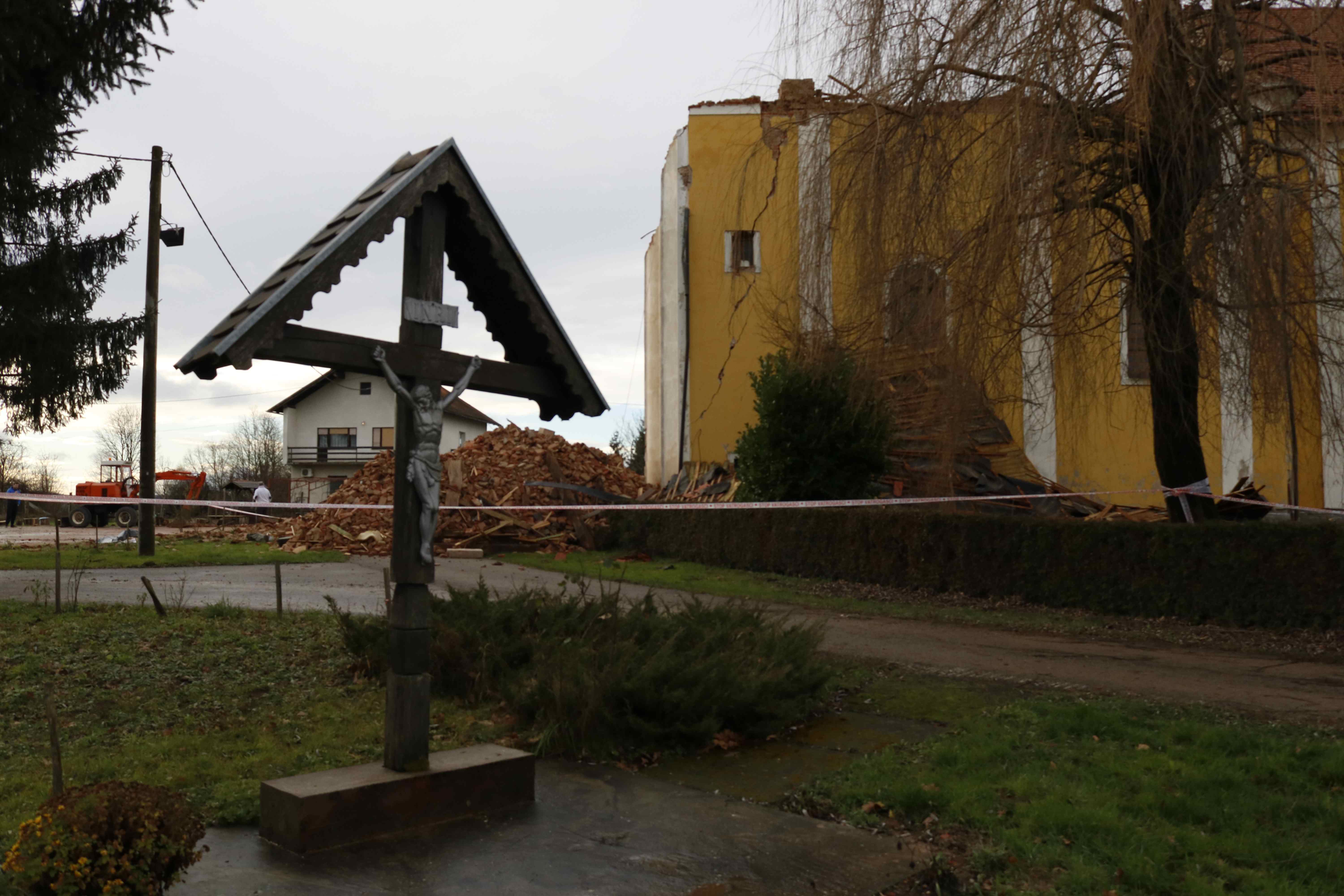
Photo of the Parish church of St. Nikola and Vida, Žažina courtesy of the church, all other photos © Marc Rowlands
Majske Poljane, Glina, Petrinja: A Foreigner View of Croatia's Emergency Response
December 30, 2020 - A day after the devastating Petrinja earthquake, TCN visits Majske Poljane, Glina and Petrinja, finding tragedy, humanity, and Croatians pulling together with huge hearts.
My first and only previous visit to Petrinja was in the winter of 2003. For reasons which now escape me, I went to pick up a Ukrainian employee of OSCE and his son. The son had a broken leg and my task was to transport him to hospital in Zagreb. Of Petrinja, I remember very little apart from the snow, the cold, and the many destroyed buildings after years of war and enemy occupation less than a decade previously.
Not much good has happened to the people of Petrinja and surrounding areas in the 25 years since the war finished. Unemployment, emigration - a sadly common story in continental Croatia outside the capital Zagreb. An earthquake measuring 6.2 was felt in ten other countries and every part of Croatia yesterday - it was my first earthquake experience, over lunch in Varazdin, 140 km away - powerful enough to have us leave the house immediately.
As TCN covered the aftermath, it was clear that a major tragedy was unfolding, with 7 deaths reported within hours. International messages and pledges came pouring in, and international interest in the live updates was huge. I decided to go and visit the next day, so that perhaps an in-depth account of the situation on the ground might help people understand the scale of the tragedy, as well as painting a realistic picture of what was happening on the ground.

Unsure of how busy the roads would be, I left home in Varazdin at 5 am, picking up TCN colleague Marc Rowlands from Zagreb on the way. Never having done anything like this before, we decided to start in the small village of Majske Poljane, where four of the seven deaths had occurred, and where the mayor had claimed that only 10% of buildings were not damaged.
The mayor was not exaggerating.
The fog was thick at times, and our hearts sank the more we drove along the narrow main road. How does a community recover from something like this? Rebuild?

A shell-shocked man was standing by the side of the road. His house was more or less intact, but he was alone and without power. His neighbours had not fared as well. On hearing I was English, he told me that he was a war veteran and had fought side by side with an Englishman in Vinkovci in 1992 in the 109th Brigade.
"Was his name Steve?" I asked, the only Englishman I knew in Vinkovci who fought for Croatia (and DEFINITELY the only Englishman to open a pub in a field in the middle of nowhere in eastern Croatia).
" Yes, Steve. He probably will not remember me, or recognise me after all these years." I suggested we try and sent Steve the photo above to find out - the reply came back that the face was familiar. Such is the smallness of the village that is Croatia.

While Vladimir's house was in reasonable condition, the same could not be said of the neighbours' house across the road. Yesterday, this had been an inhabited home. Today, inhabited only by at least 10 horses that I counted, one of which was tied to a tractor. All were shellshocked.
I told various media colleagues I came across today about the horses, and they featured on the national news this evening, and I recently heard that a container of help has arrived at the house, including help for the horses.

Ours was not the only car with Varazdin plates in Majske Poljane. They came from Varazdin, Cakovec, Zagreb, Vukovar and Bosnia. Volunteers, Croatians and foreigners with their cars filled with food, blankets, water, clothes, looking for locals to donate to, to help them through this difficult period.
Vladimir had already received a visit from the Red Cross yesterday, and they brought food, blankets and clothes. He took only a little food, as the need for the rest was perhaps greater with others.

It was a theme of the day - cars from all over Croatia (here, Nasice) filled with supplies to help the people of Majske Poljane, Glina, Petrinja and Sisak.
Of all the countries I have lived and travelled in, never have I seend a nation come together in time of crisis in the way Croatia does. As my heart was breaking with the horror scenes all around, it was also beaming with pride at the efforts of my adopted homeland.

The humans of Majske Poljane may have been confused by what had happened, and so too were the animals. From those horses to the bleating sheep and many dogs either wandering around confused or guarding houses which no longer existed, the loneliness and loss of direction of beloved pets was as poignant as anything I saw today.

We made our way back through the mist to the other side of Majske Poljane, to be greeted by the Croatian army, just part of the emergency response.

They were soon at work, setting up temporary shelters.

Great teamwork, obviously well-practised.

And within 15 minutes, mission complete for the first tent.

We headed on to the nearest town, Glina, which was also badly affected. On the way, by the side of the road, piles of rubble from the damaged houses. Neatly arranged, waiting for the authorities to collect them.

This is the photo a friend from Petrinja sent me yesterday. Cleaning this up was going to take forever, surely?
We couldn't believe how clean the streets of Glina were, until we saw the local teams in action.
One section complete, on to the next.

Some things will be impossible to fix.

The fire brigade was out in force, removing loose debris and making buildings as safe as possible. Lots of loose chimneys were removed in the region today.

From Glina to Petrinja, but there was plenty to observe on the way. A beautiful stone church in Gora, victim of the quake, huge chunks of stone lying in its gardens. A local told me that the church is only a few years old, having being rebuilt after the Homeland War.

The entrance to Petrinja.

With no fixed agenda, we decided to follow things that interested us. Such as the Red Cross on quad bikes delivering emergency water.

It was hard to keep up as they went house to house, with local residents coming out to collect their allocation. Efficient, innovative, and very effective.

One of the most heartwrenching sites of the day were the numerous families sitting in their gardens and yards outside, with basic supplies of food and water. Others were just standing there, looking lost. With the threat of more tremors, no electricity, and nowhere to go, many just sat outside in the cold and waited. There were so many incredible photos to be taken, but neither of us wanted to be that intrusive.

But perhaps a flavour in this collage from a LinkedIn contact.

And so to the centre of Petrinja, whose collapsed buildings have become the most iconic of this latest disaster.

Horrifying.

But then, the strangest thing... Look the other way into the centre of the square to find a beautiful Advent in Petrinja park, seemingly oblivious to the chaos all around.
A video tour of a tale of two Petrinjas in one square.
And I thought back to my friend's photo the previous day - the streets of Petrinja were incredibly clean so soon after such a catastrophe.

Another reason, perhaps, why people were just sitting around in their front gardens was that there was nothing open. Cafes and restaurants have been closed for weeks due to corona, but the shops and supermarkets were also shut. But there was little chance of the people of Petrinja going hungry, as there was help from every corner of Croatia. I stopped to take a photo of 'Sinj Loves Petrinja.'
"What would you like?" asked the man in a strong Sinj accent.
"I would love a cold beer," I replied.
"Sorry, no beer but we have lots of other things. Take what you need."
"Haha, I was joking. I am a journalist, I don't need anything but thank you."

A woman approached asking if they had any bread, and she took what she needed for her family. Such things happened all over the region, gifted by people from all over the country, today - it was heartwarming to see.

And everywhere, the volunteers, waiting to be allocated their tasks. Everything is being very well-coordinated by the local civil protection units.

Marc wanted to take some photos of something along the road, and I found myself watching this old couple whose house had been damaged, urgent repairs to the roof a priority.

Within minutes, a team of volunteers appeared with a ladder and set to work. Such things happened all over the region, volunteers from all over the country, today - it was heartwarming to see.

There was one appointment I had that I was keen to keep - finally meeting Josip Granic and the amazing team from the Croatian Mountain Rescue Service, whose headquarters were in the Lidl car park.

We are curiously bonded by both being unlikely male models (ok, he far more likely than me) in the Varteks 'Imperfect Guy in a Perfect Suit' campaign. Josip is a big TCN fan and was very helpful in a great feature on the amazing team at the Croatian Mountain Rescue Service by TCN earlier this year - Meet HGSS The Croatian Mountain Rescue Service.
Despite working through the night without any sleep, Josip found time for an interview with Marc, which we will publish tomorrow.

Police road checks in the earthquake era. I was expecting much more traffic congestion, but the police kept things moving.
What the police could not control were more tremors. Alone in the car again as Marc took more photos, the car started to move side to side, and the earth was definitely moving underneath me - a 4.1 earthquake I was to discover later. Par for the course in Croatia in 2020 and nothing to write home about.

And the traffic kept flowing, bringing the essential items to the locations which needed them most.

The damage was everywhere, and for all to see.

Some with memories of the celebrations of a happier festive season, just a few days ago, when life was very different.

There was time for one more stop before returning to Zagreb - the church in the village of Zazina. Its front and spire no longer there.

Ripped from the rest of the building.

This is how the church had looked just 24 hours earlier. I learned later that the church organist had been cleaning the organ when the earthquake struck, and he was tragically killed.

The frescoed walls inside still there to see.

Young versus old, as the neighbour emerged without a scratch. But as we saw with the church in Gora, young does not necessarily guarantee safety from earthquakes.
We drove back to Zagreb in relative silence, each lost in their own thoughts and suffering from the early start and the trauma of the day.
A harrowing day for sure, but also a heartwarming one. Croatians are the most resilient people I know, at their finest in adversity. There are thousands of heroic examples of this being performed on a daily basis at the moment, and I applaud each and every one of them who has risen to the task.
And let's not forget the generosity of the diaspora and international community as well. The response to this disaster has been magnificent, as has been the emergency response. Help IS getting to those who need it most on the ground, and the donations ARE making a difference.
For more on the Petrinja earthquake, follow today's live updates. For more on how you can help and donate funds, food, material and humanitarian aid, click here and here for the details of a special (free of additional charges) HPB donation account for Grad Petrinja.
Village outside Glina Worst Hit by Petrinja Earthquake
ZAGREB, Dec 29, 2020 - Majske Poljane, a village outside Glina, about 70 kilometres south of Zagreb, was worst hit by the 6.2-magnitude earthquake on Tuesday, the deputy mayor of Glina, Branka Baksic Mitic, said.
"There are hardly 10 percent of houses here that have been left intact. People are still being pulled out from under the rubble. Glinsko Novo Selo was also hit severely, but there are no casualties there. The largest number of casualties are here," Baksic Mitic told the Index.hr news website.
She said that tents were being set up on a football field in Glina for people who have been left homeless by the earthquake. She appealed for shipping containers to use them for accommodation. "It's winter and these people have nowhere to stay," she said.
Baksic Mitic confirmed that four people had been found dead buried underneath the rubble.
Glina Primary School said it had opened the doors of its gym to people without shelter.
You can follow live updates here.


